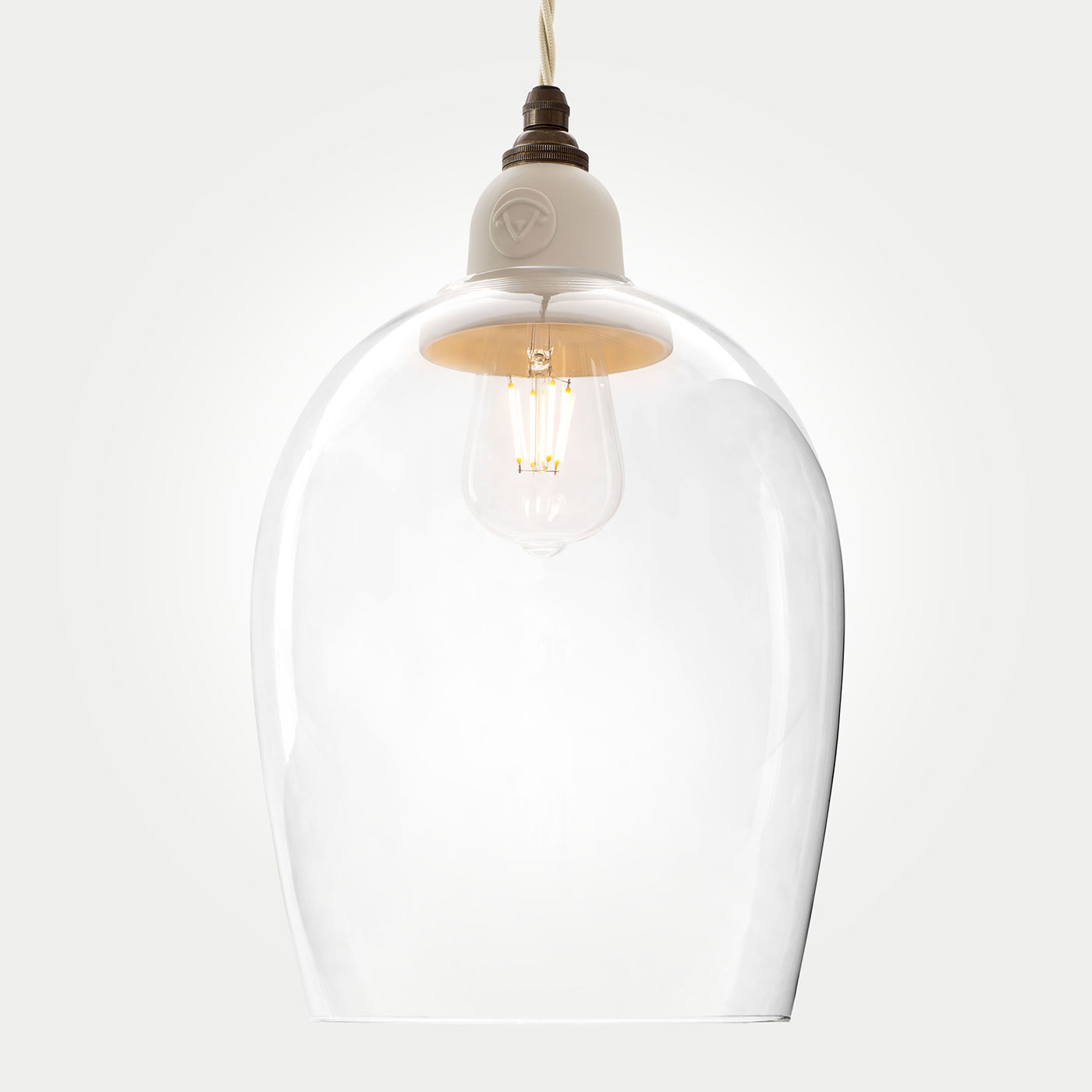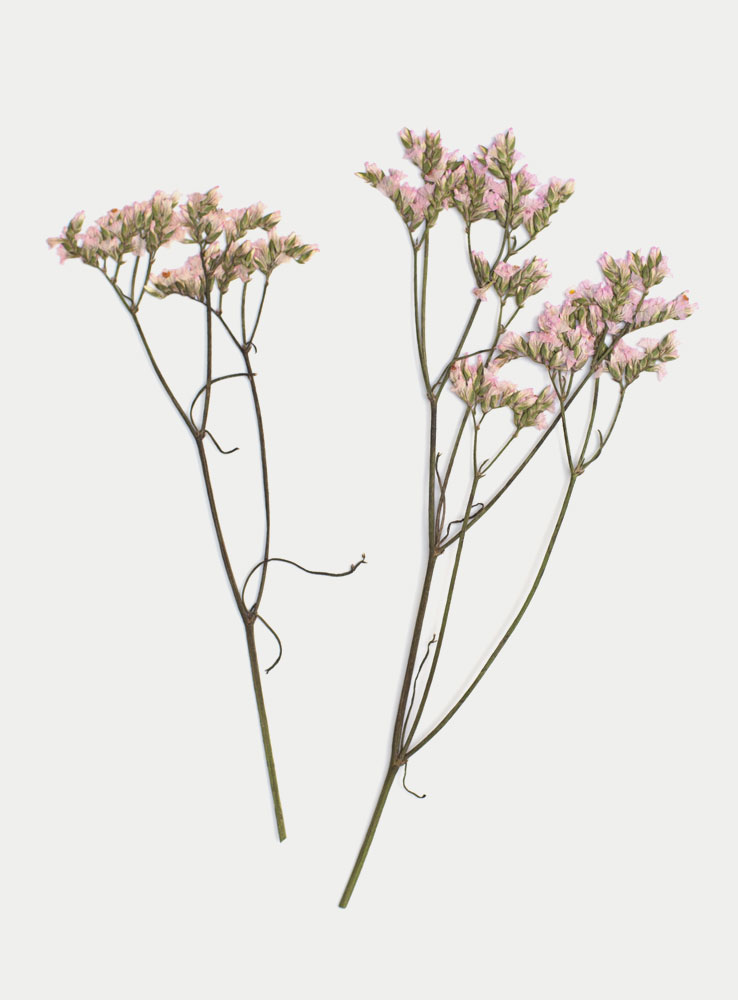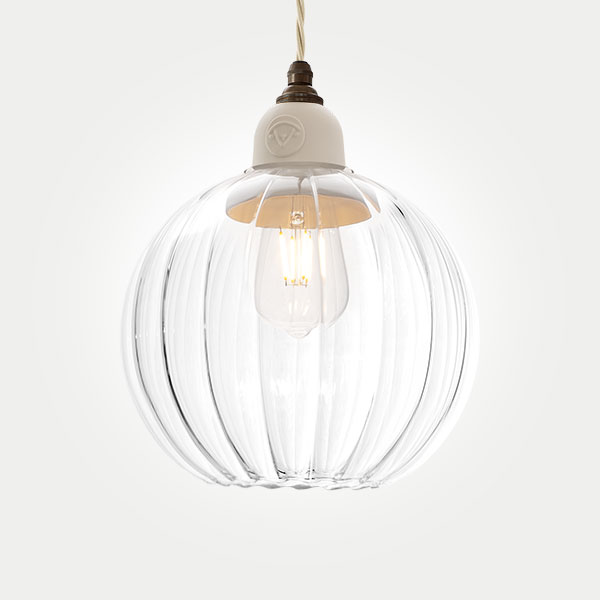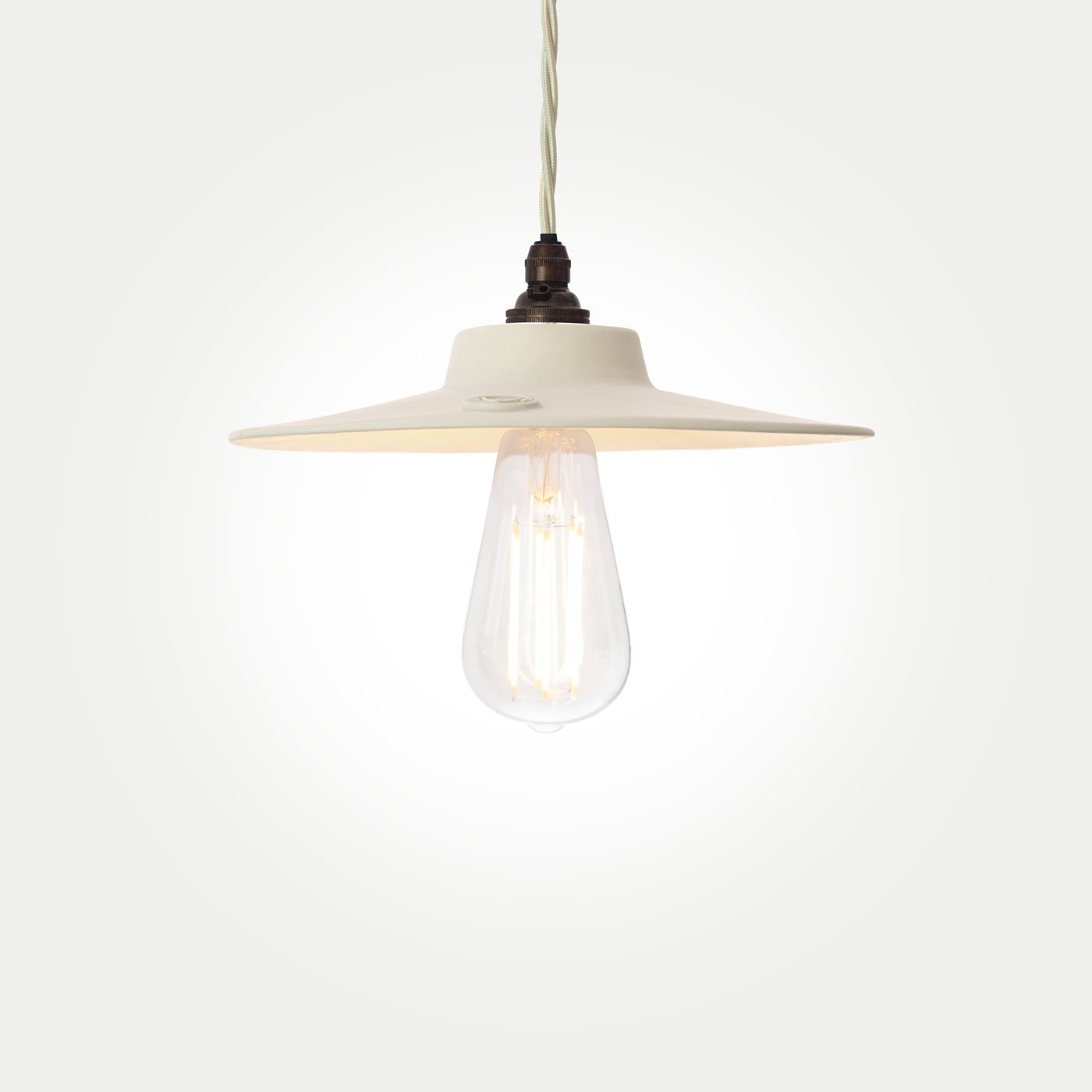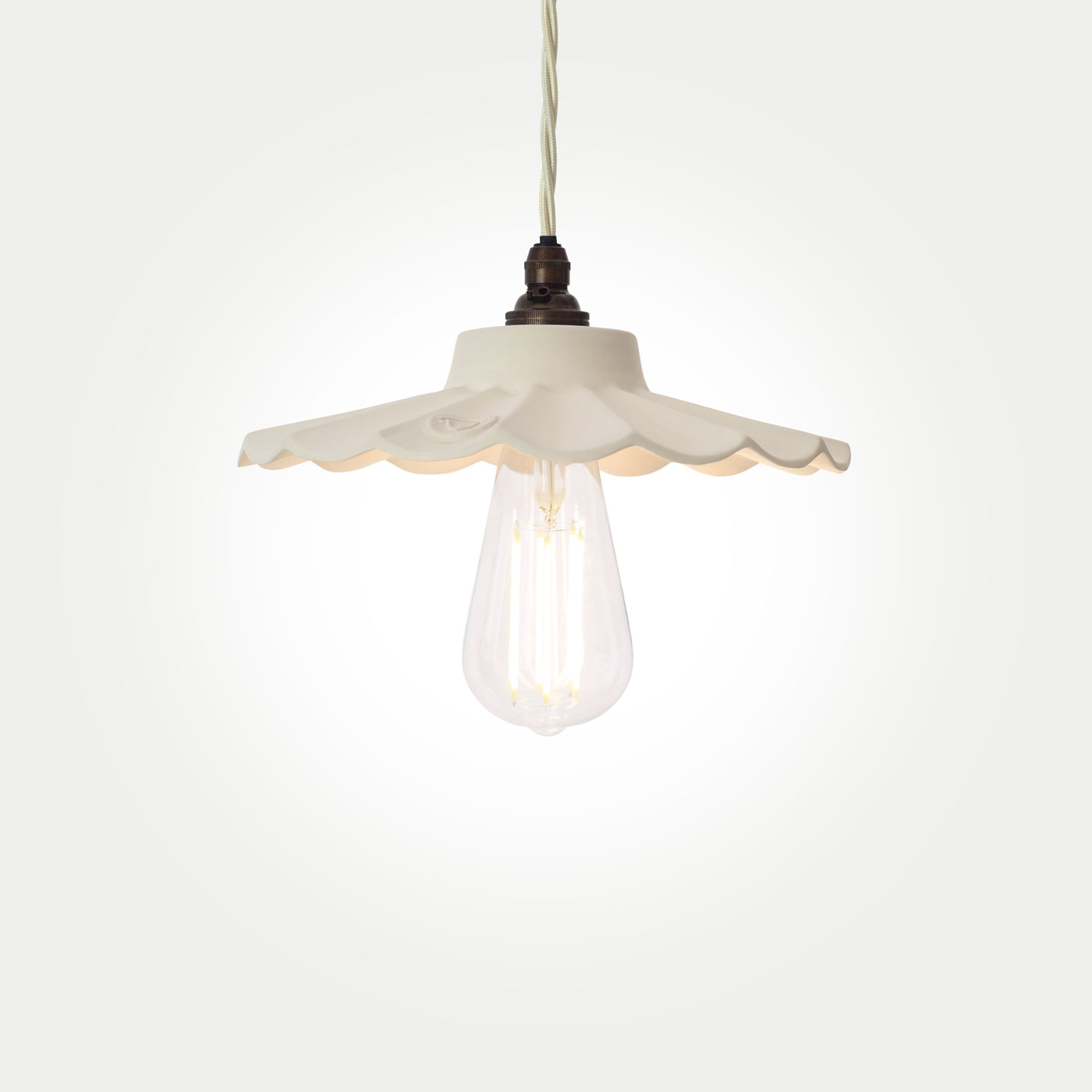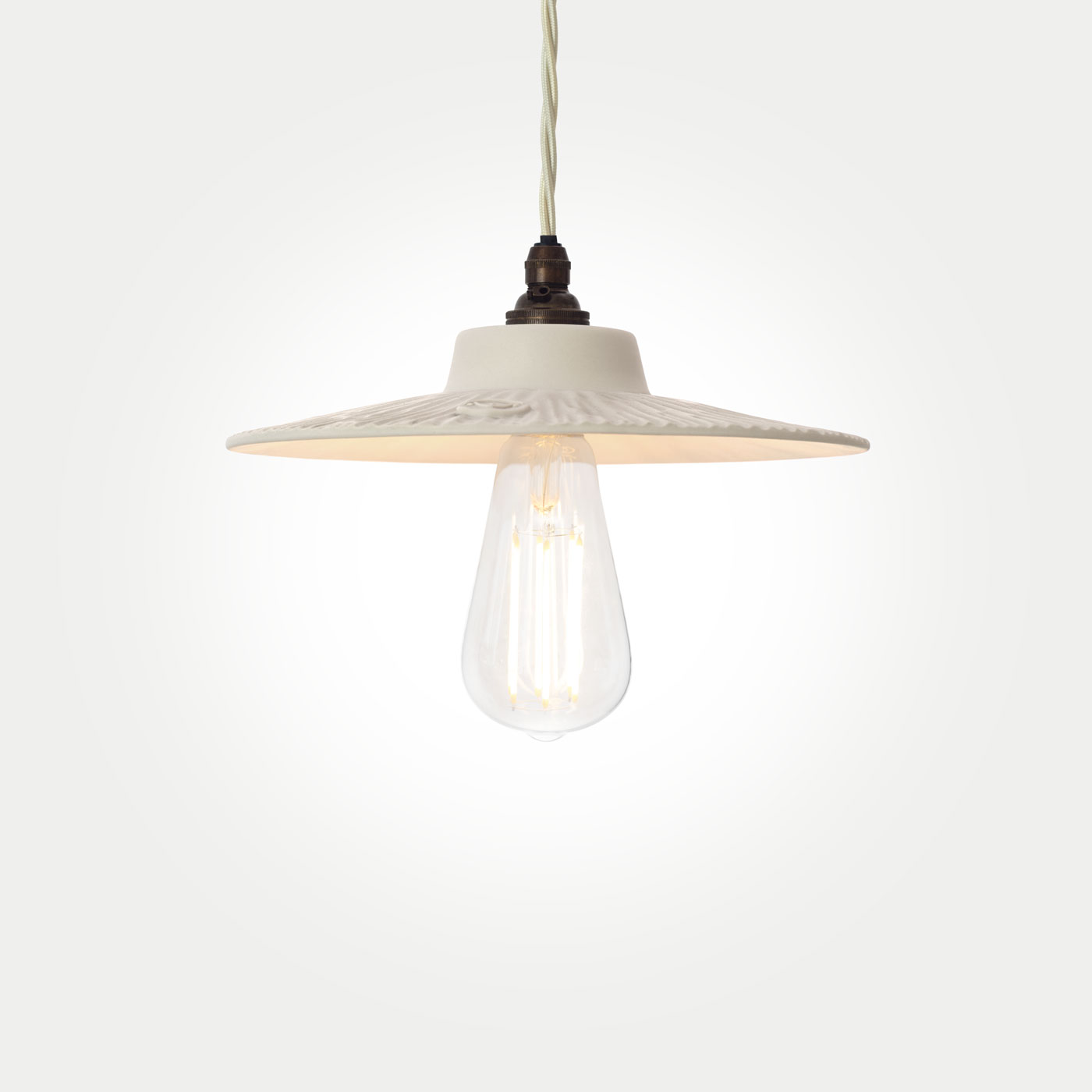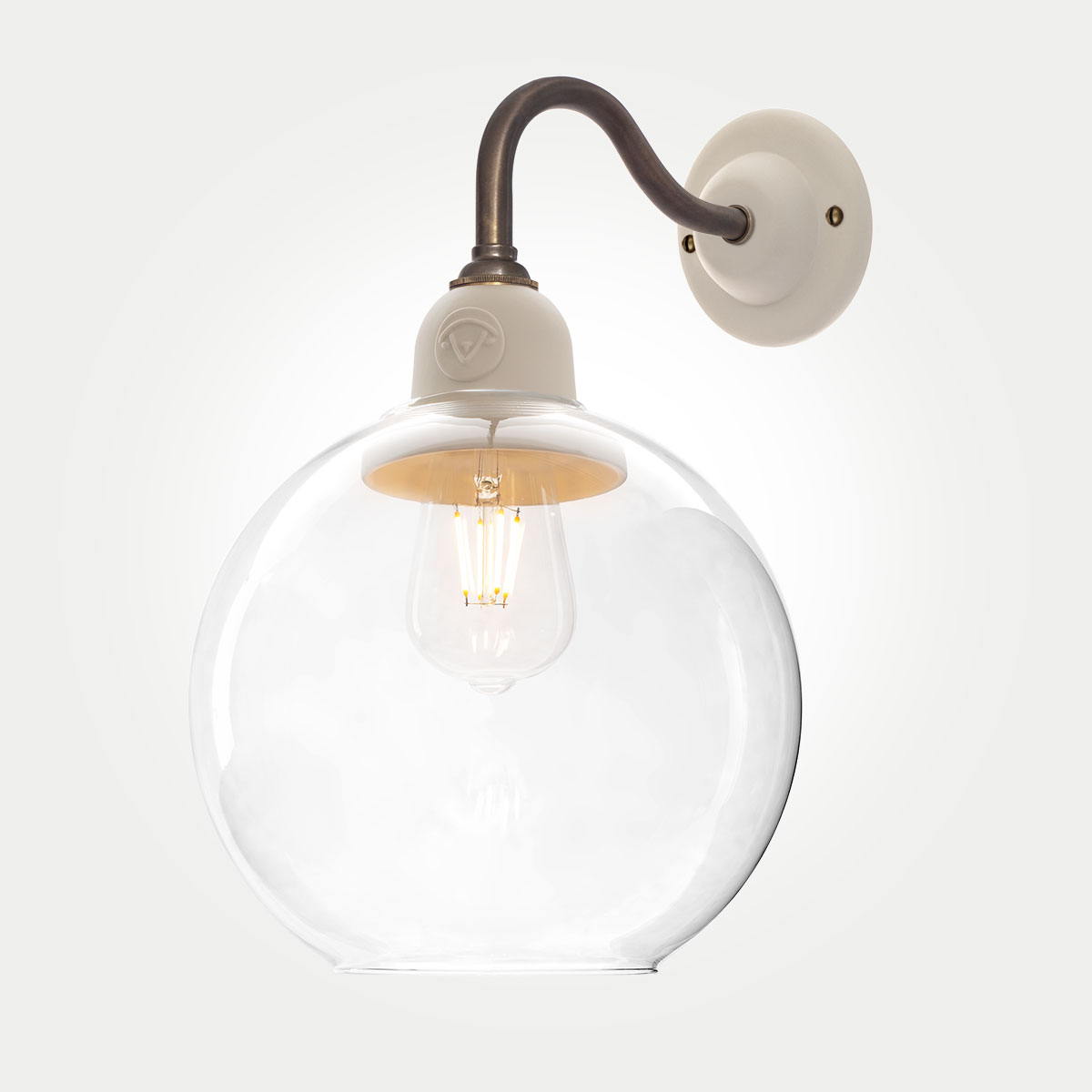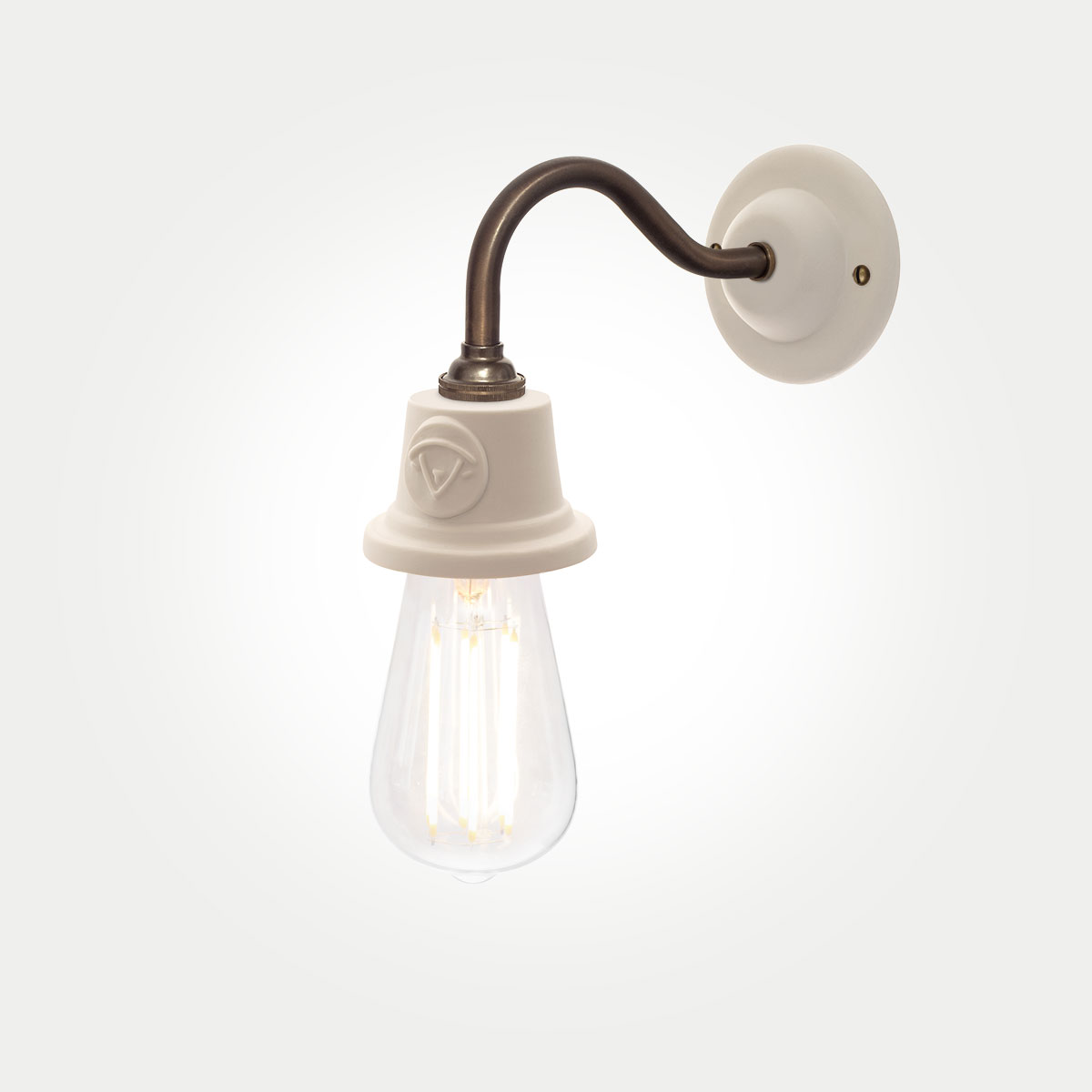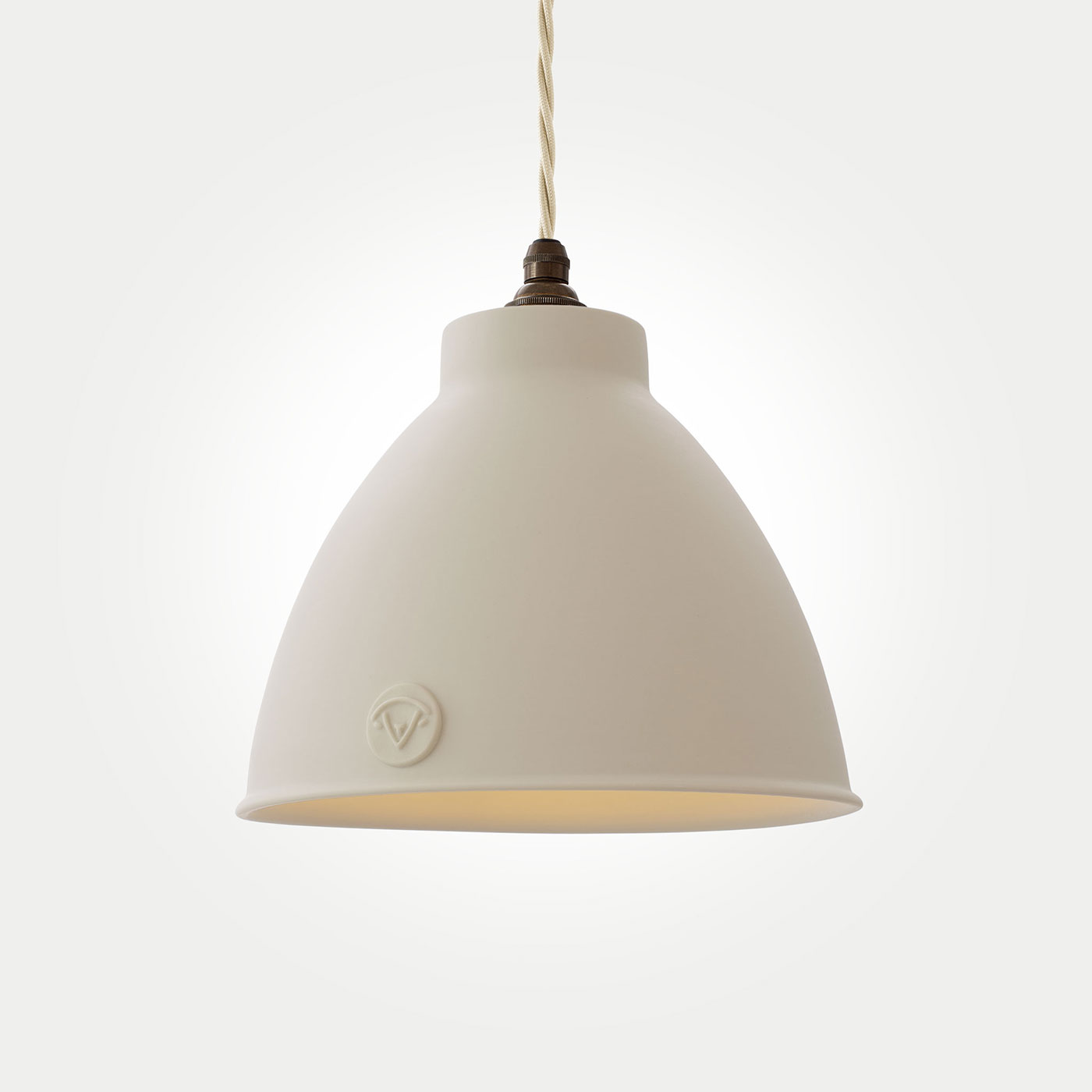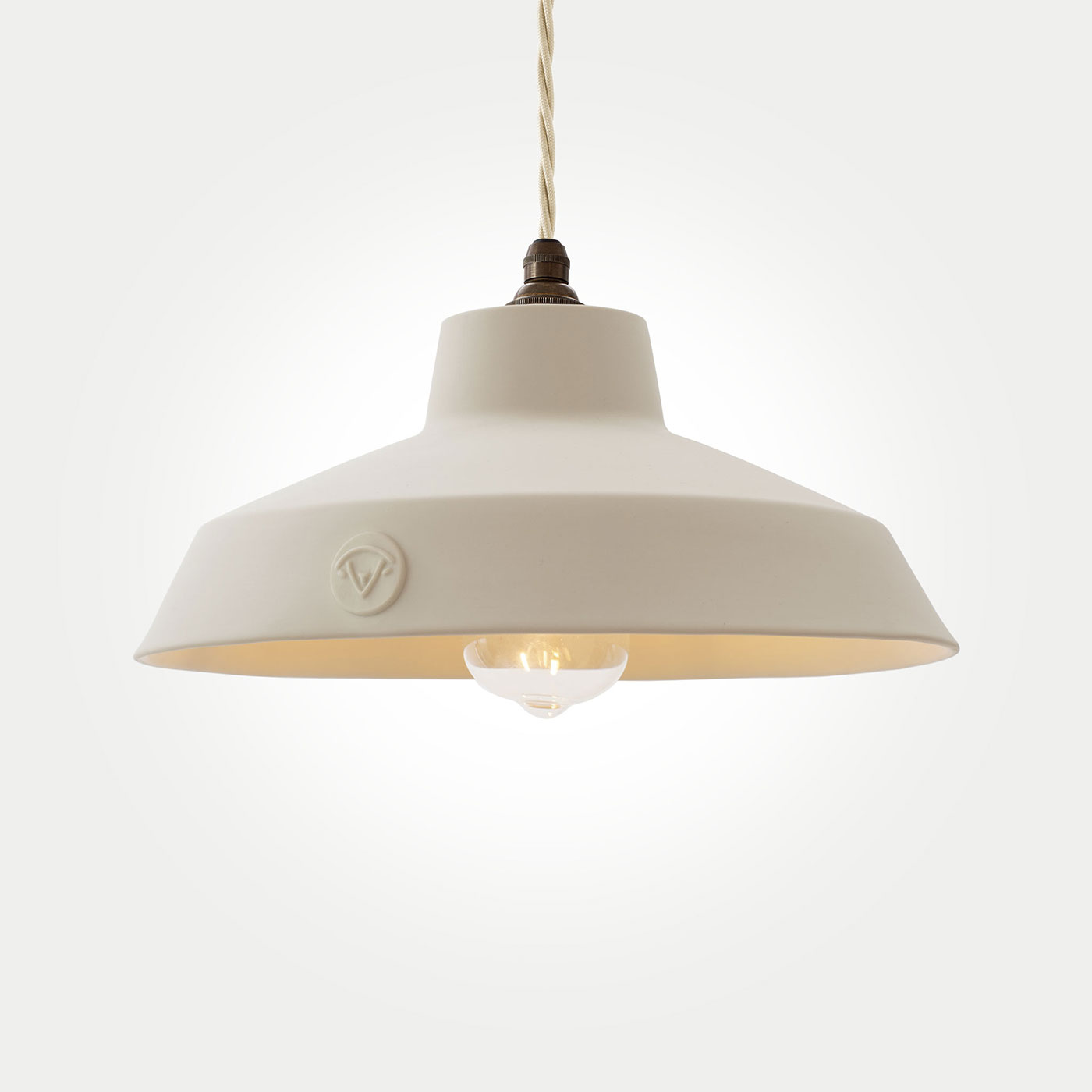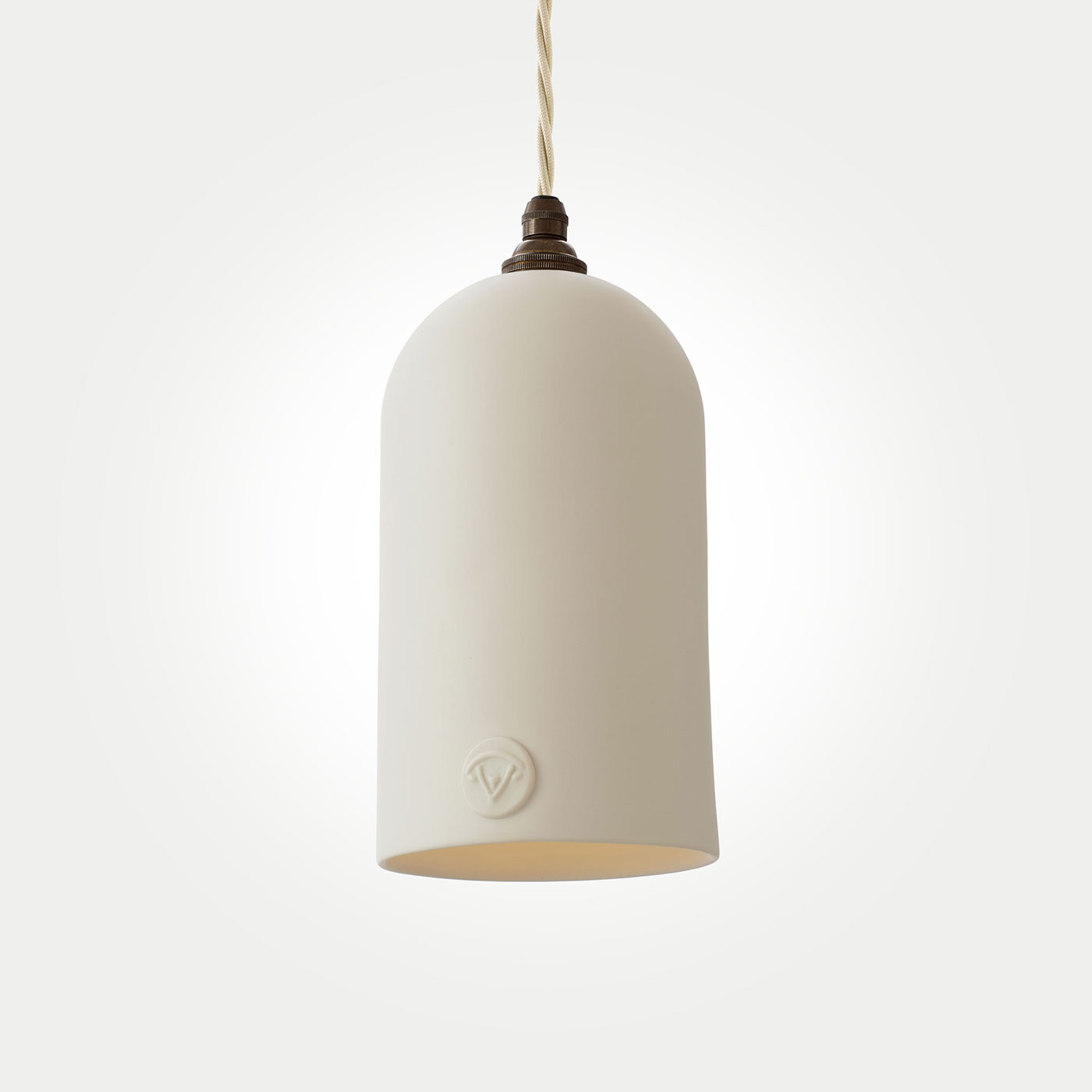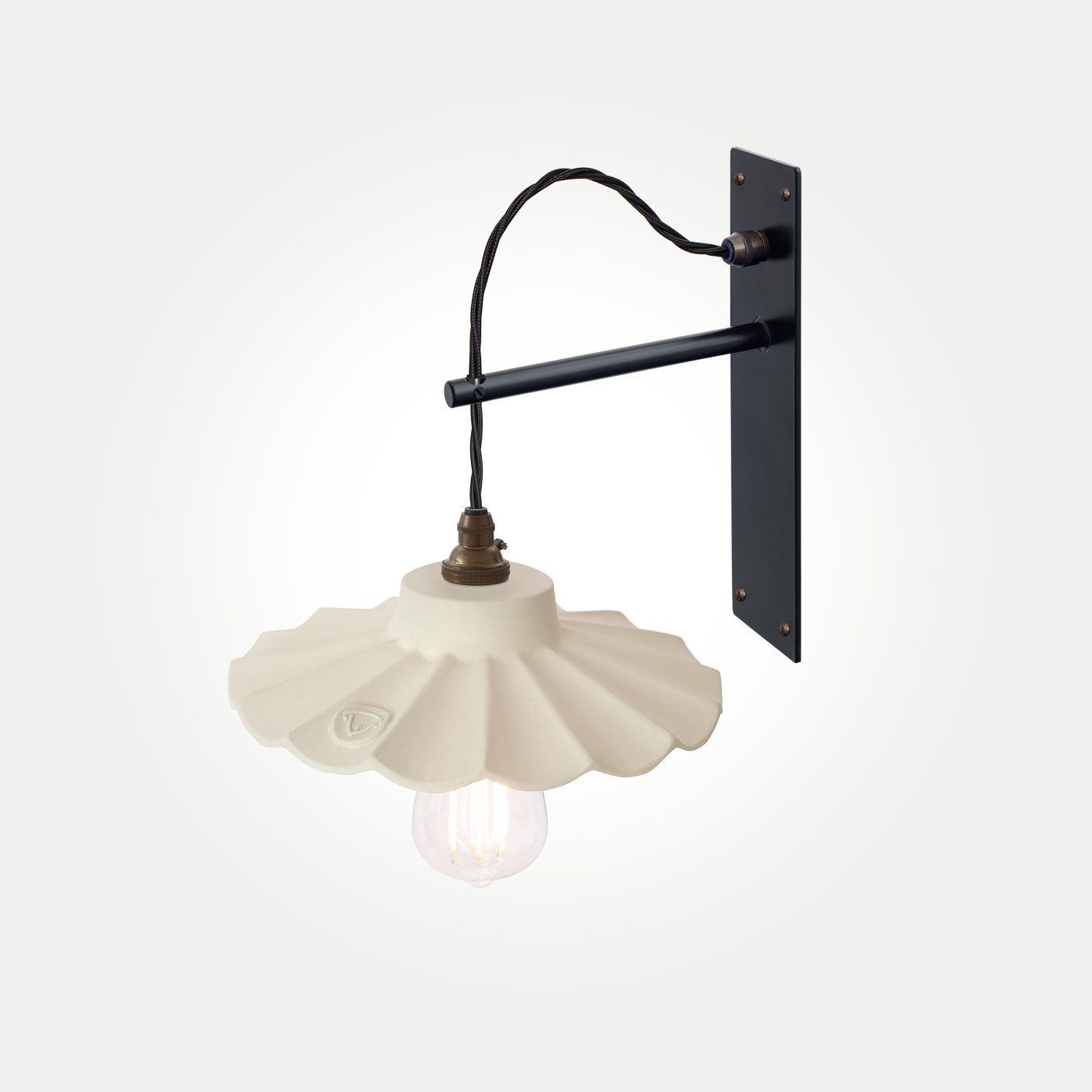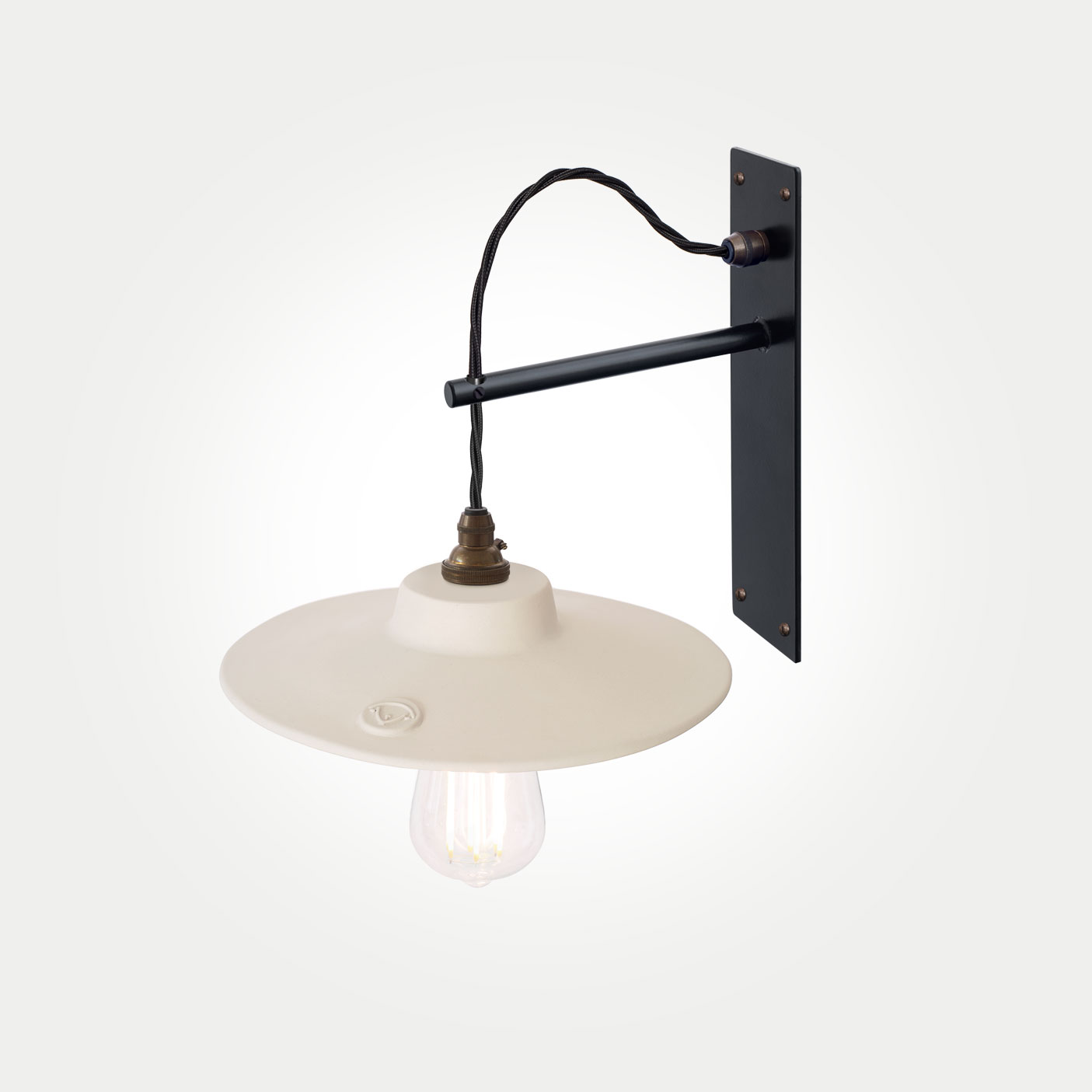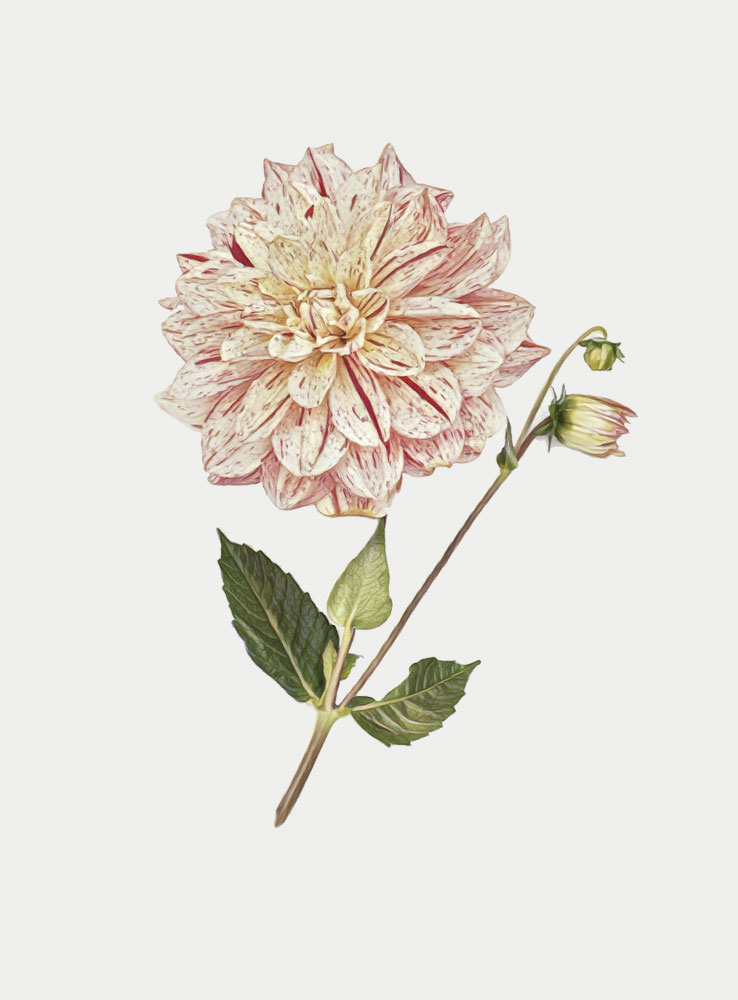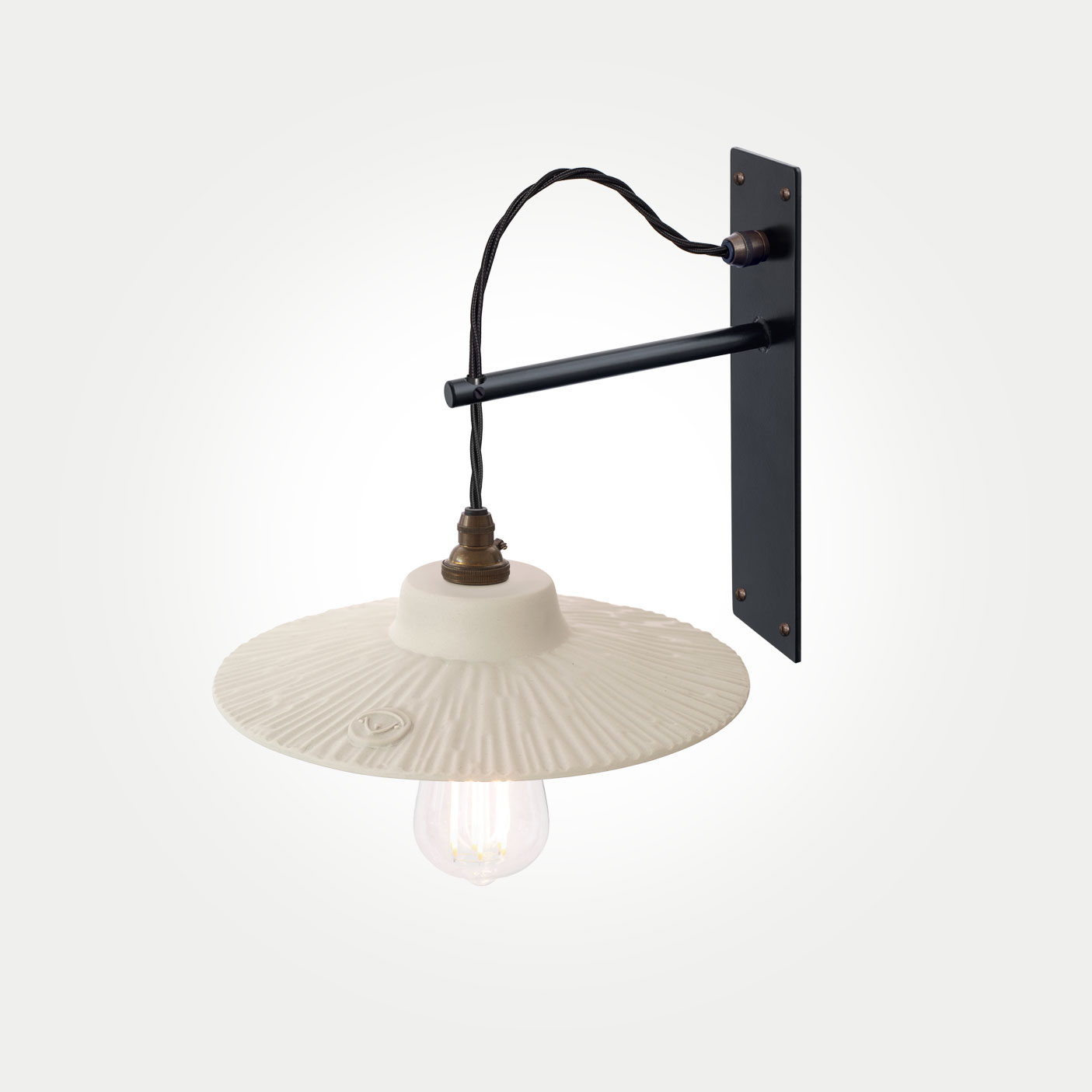Kitchen Lighting

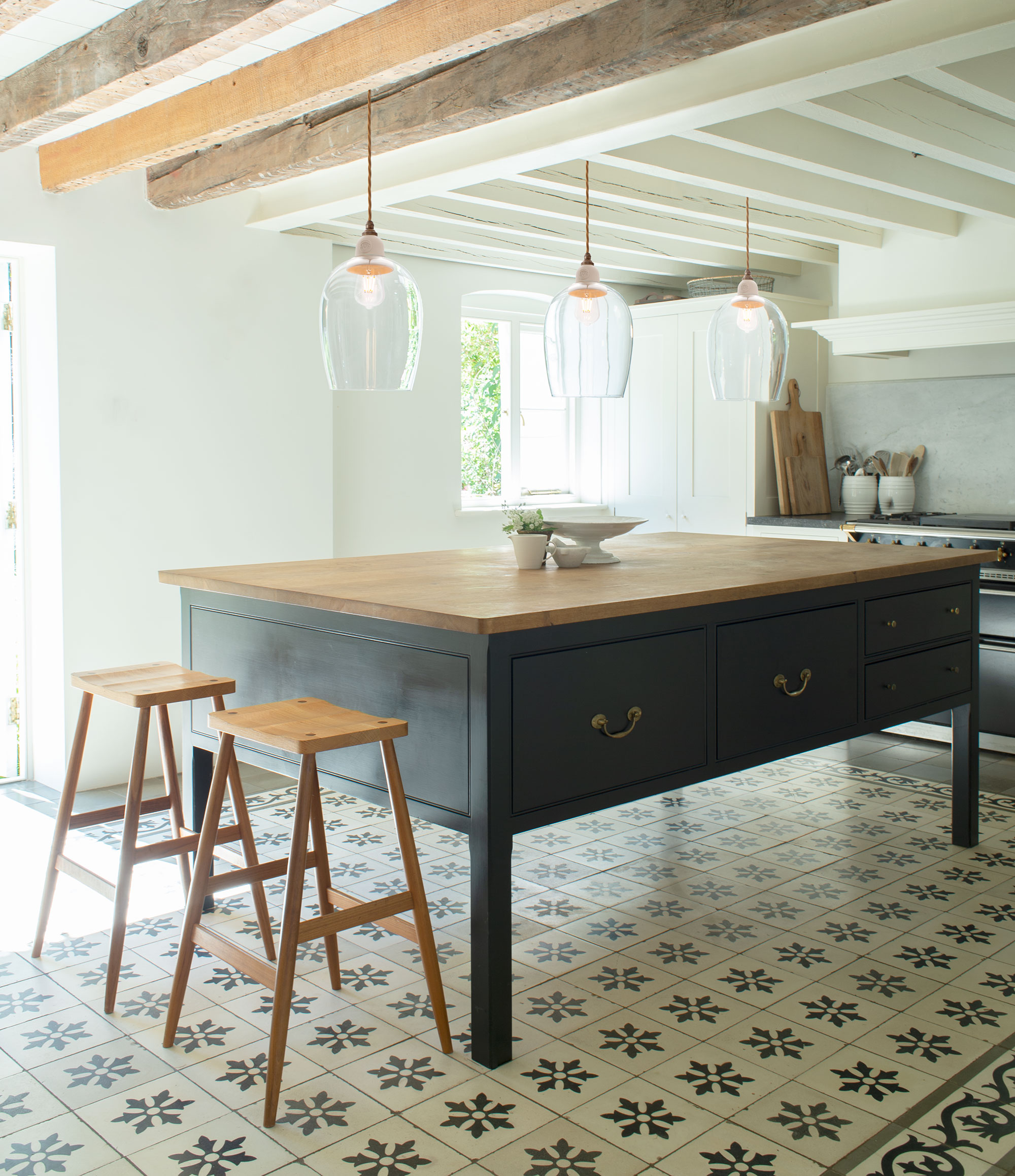
The space where we come together; to cook, to eat and to entertain. Lighting your kitchen should be a joy and a chance for you to express your unique style. Whether it’s to update your existing kitchen or you’re starting with a clean slate. We have done our best here to inspire you, breaking down kitchen lighting into three parts.
Put simply, kitchen lighting can be broken down into 3 types: Ambient, Task and Feature. Think about your kitchen lighting as one cohesive scheme, pick and choose which parts of this guide are relevant to you. Remember, it’s your kitchen and should reflect your own wants and needs. Hopefully, this guide will help you on your way.
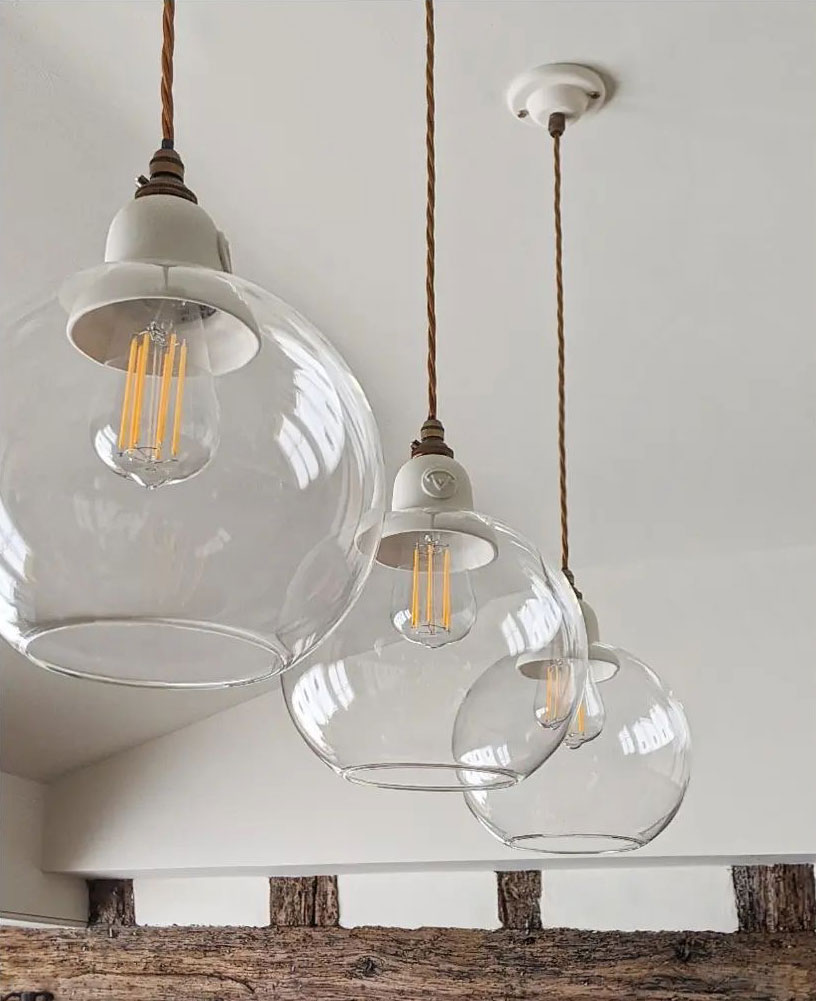
The 3 Types of Kitchen Lighting

Interior Design and Image by: Sam at Vintage Curator Interiors
Ambient Lighting: The general lighting in a room. This would often be considered the primary light, for example, the main pendants. It sets the general tone and atmosphere of the space.

Task Lighting: Practical and beautiful, bringing extra light to areas such as cooking surfaces, the sink and preparation spaces.
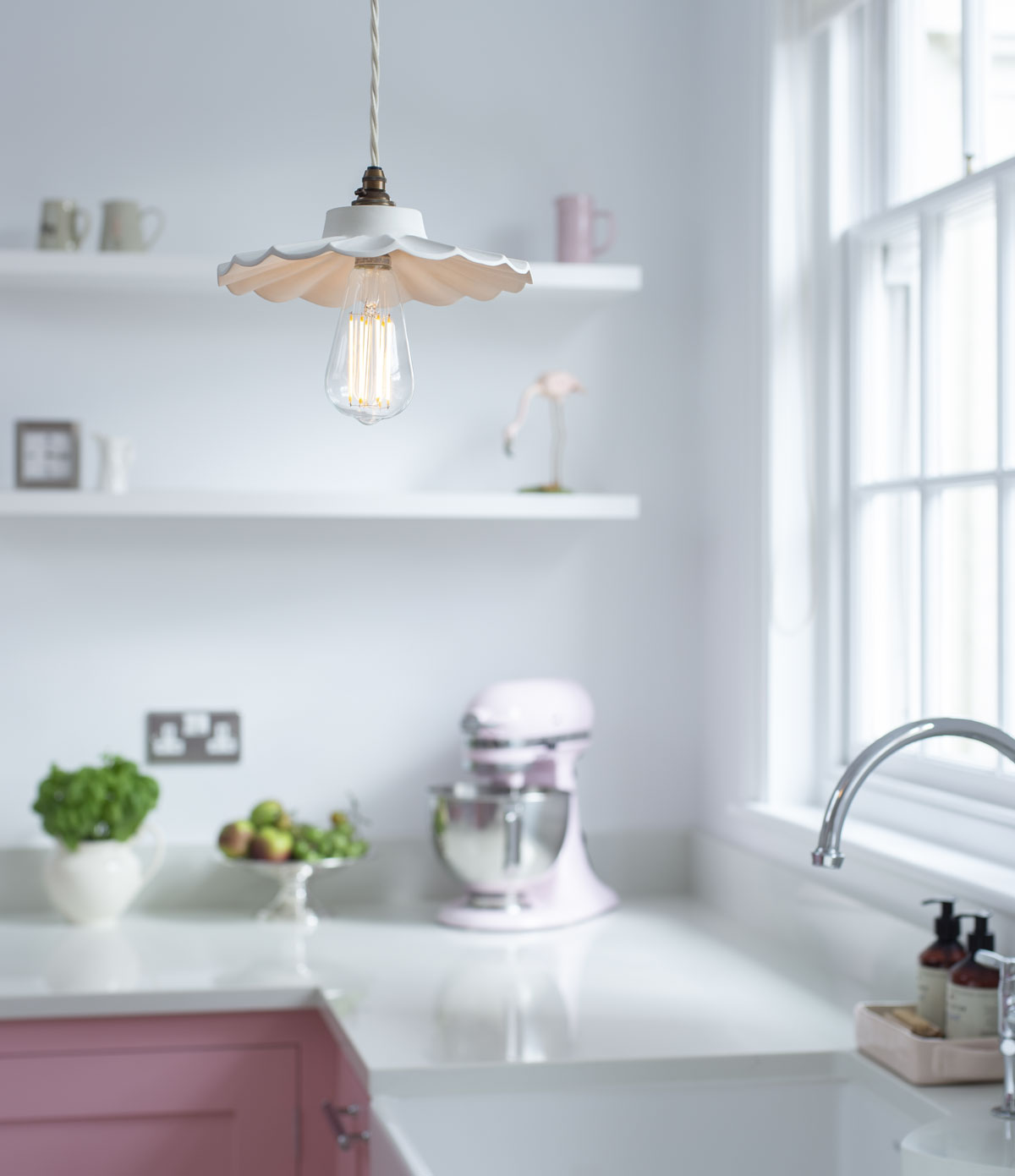
Feature Lighting: Can elevate an area and introduce character, where the light fitting itself is the object of beauty, interest and detail.
Simplicity and Purity in Form and Materials
All of our lights are made using beautifully tactile materials. Our signature porcelain features in every single one of our designs. Sourced from Limoges in France – the region famed for porcelain since the 18th century. We also use glass in some of our designs, hand-blown for its unmatched, beautifully refined finish. The marriage of fine porcelain and glass is something we have innovated at Lam Lighting.
It is worth noting the differences in these two wonderful materials for their lighting effects. The porcelain shades reflect a warm glow down and into the room. As the glass is transparent, it disperses the light widely, giving a more ambient luminance. The glass shades are all coupled with a porcelain gantry which reflects and enhances the light
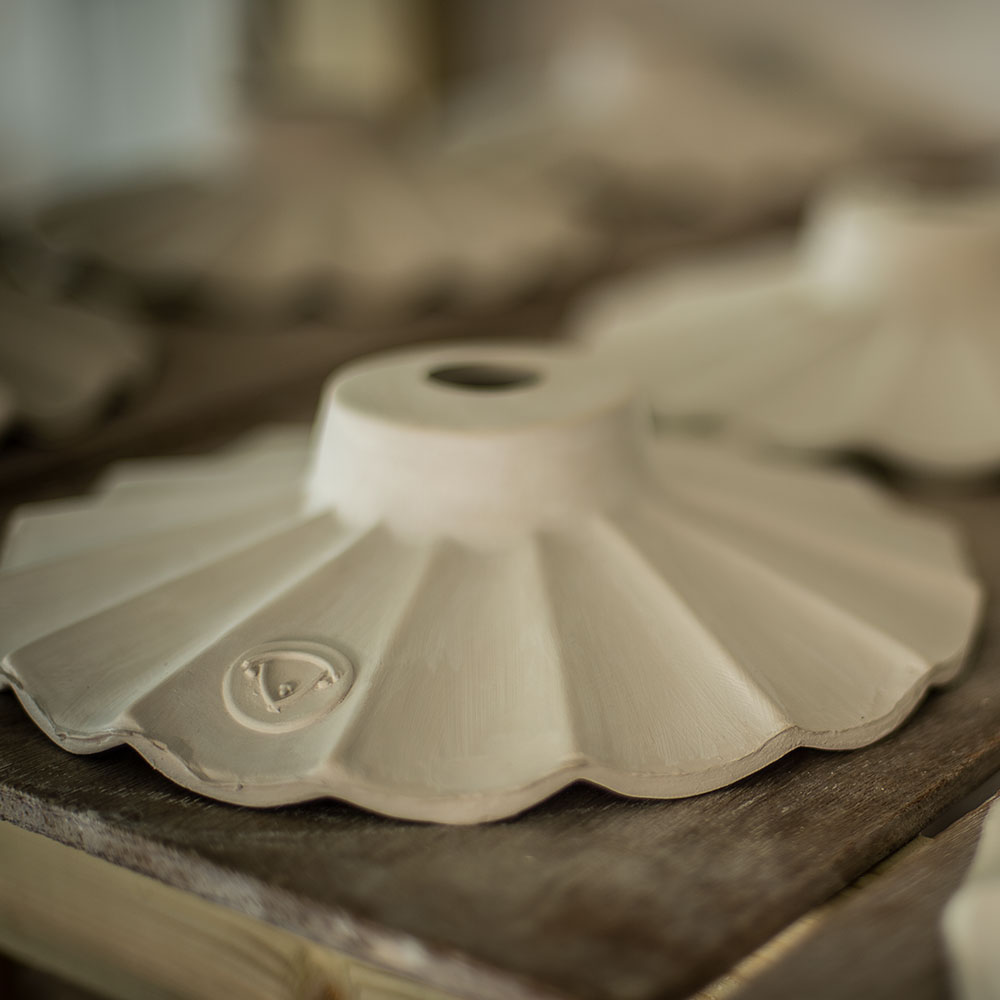


In simple terms, creating ambience is all about the effect of the light and the way that it spills into and washes over your room. The kitchen is such a versatile space, used for entertaining, socialising, cooking and relaxing, and the lighting plays a huge part in setting the tone for every eventuality. It should also be used to work in harmony with the natural light.
Lighting Your Kitchen Island
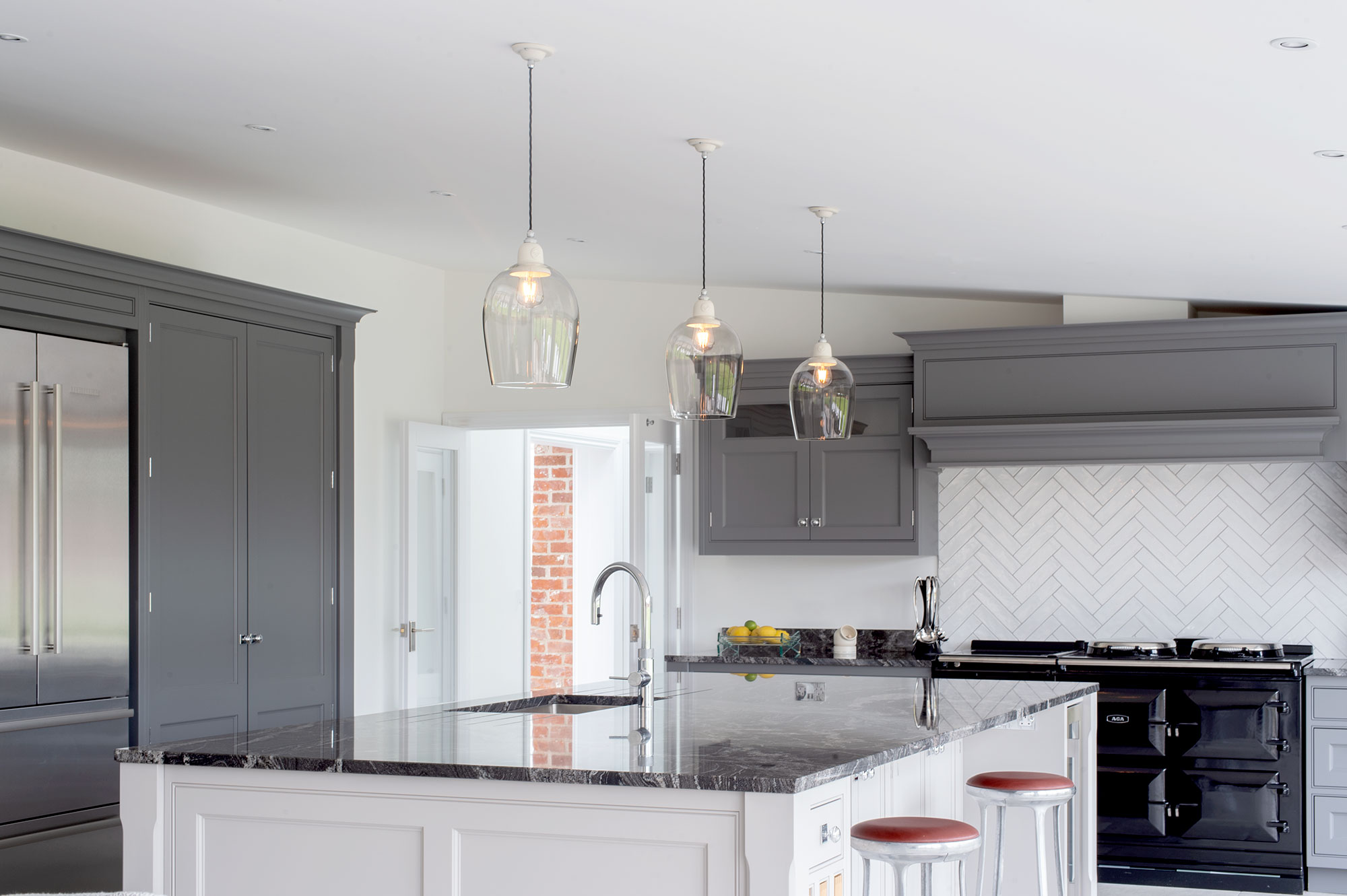
How Many Pendants Should I Have and Where Should I Put Them? // When planning the lighting for your kitchen island, it is worth considering the rule of three. Of course, this all depends on the size of the island itself, but generally and aesthetically speaking, odd numbers are more pleasing to the eye. Therefore, consider the use of three or five pendants rather than two or four.
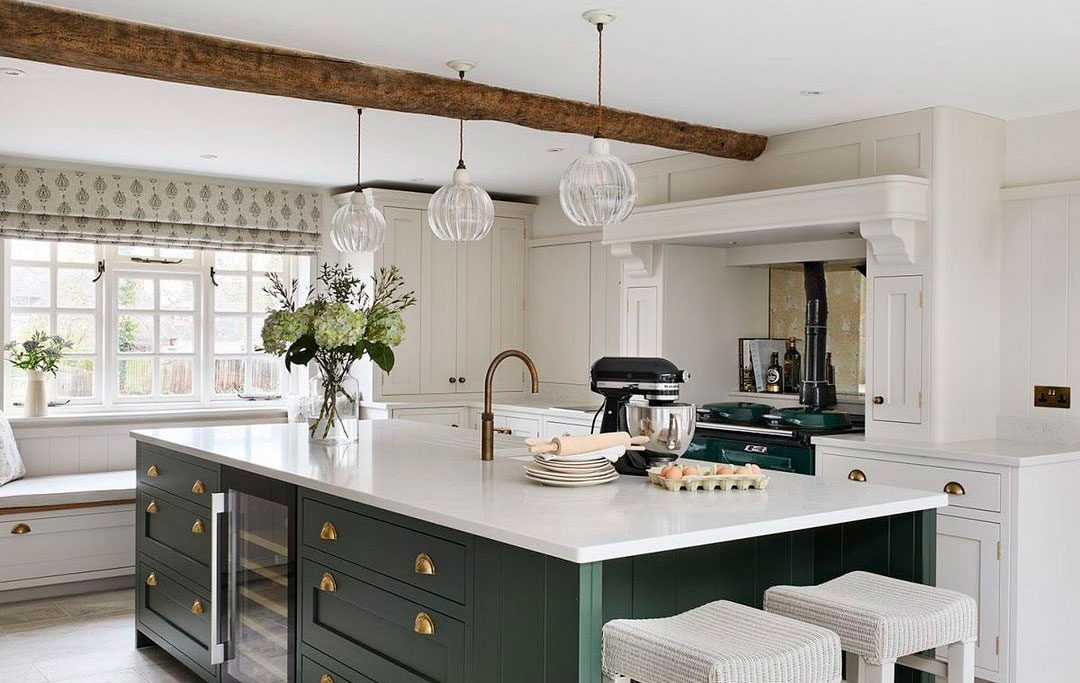
Kitchen and Image by: Davonport
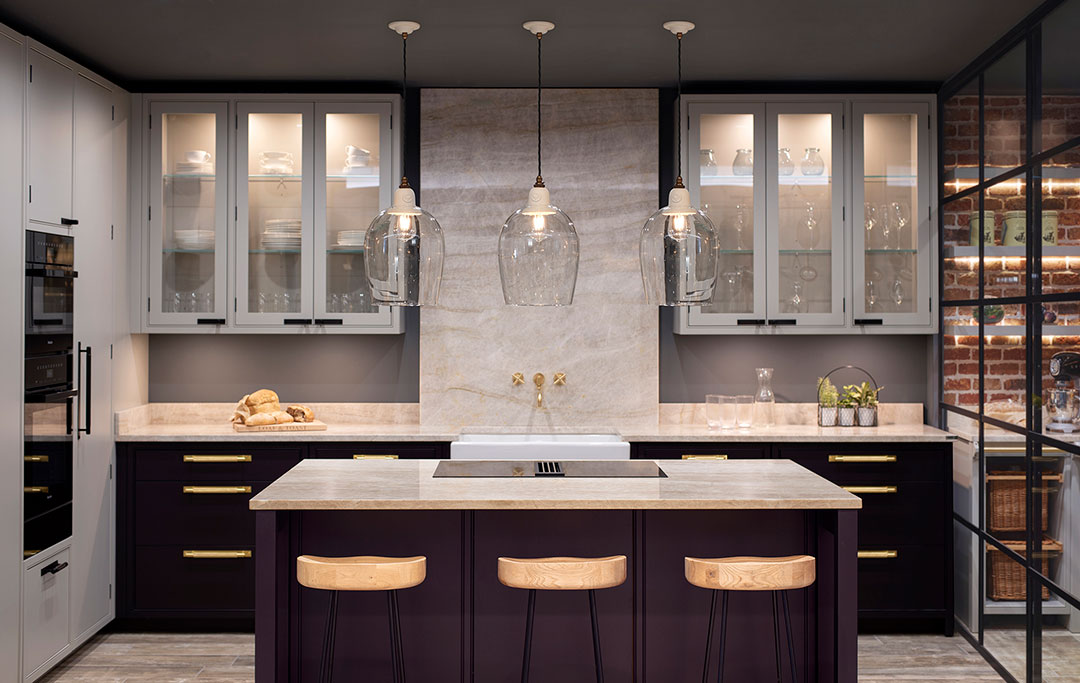
Kitchen by: Davonport
The scale of your room and the island as well as the height of the ceiling will all be factors in how many lights you have and where you put them.

There is also a question of symmetry, i.e. should your lights be central to the island or to the room? No two rooms are alike, and seldomly are any kitchens symmetrical. A common and very effective solution to deciding where to place your lights is to use balloons (you may need to purchase balloons that are slightly larger than the most common size). You can inflate your balloons to the size of your chosen pendant (all our pendant sizes are shown on the product page of each light, as well as our Light Size page) and simply tie them to thread and blu-tac them in place to get the overall effect.
In less symmetrical rooms, consider multiple sets of lights. For example, you may have a group of 3 lights off centred above your island, and additional single lights elsewhere in the room.
In a larger kitchen, consider doubling up and repeating lighting patterns that work well. For example, two lots of triple rows, or pendant and wall light pairings.
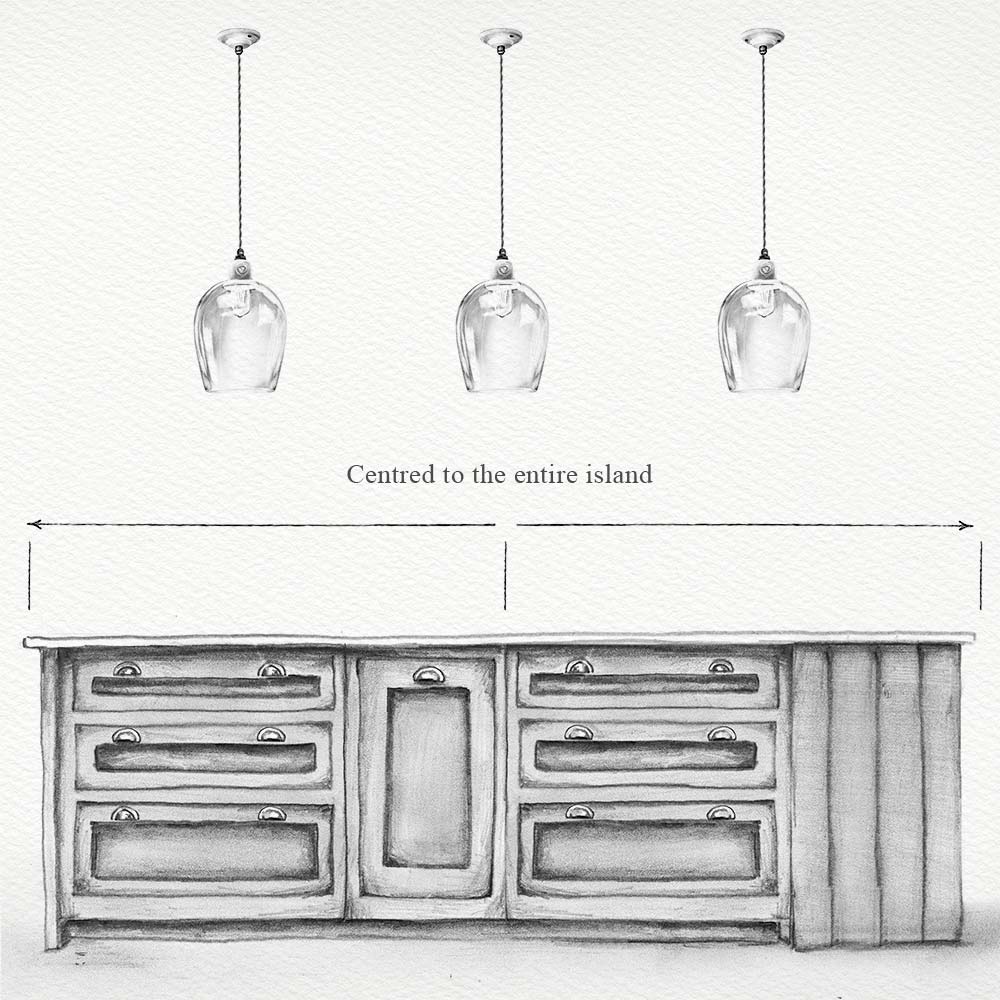
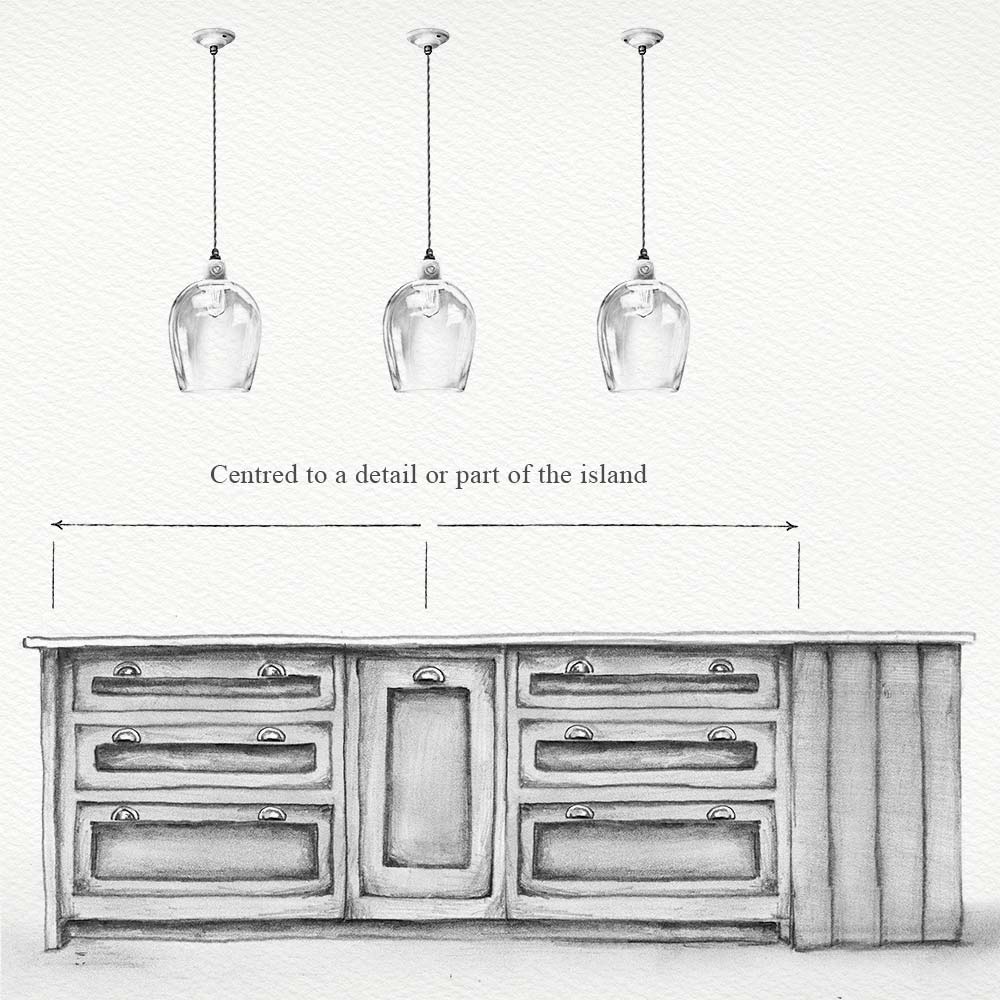
Distancing
There are no hard and fast rules about how far apart your pendants should be, however, generally the gap between them would not be less than 22cm. Once the gap becomes larger than 1 meter, you could consider adding additional pendants to cover the length of your island.
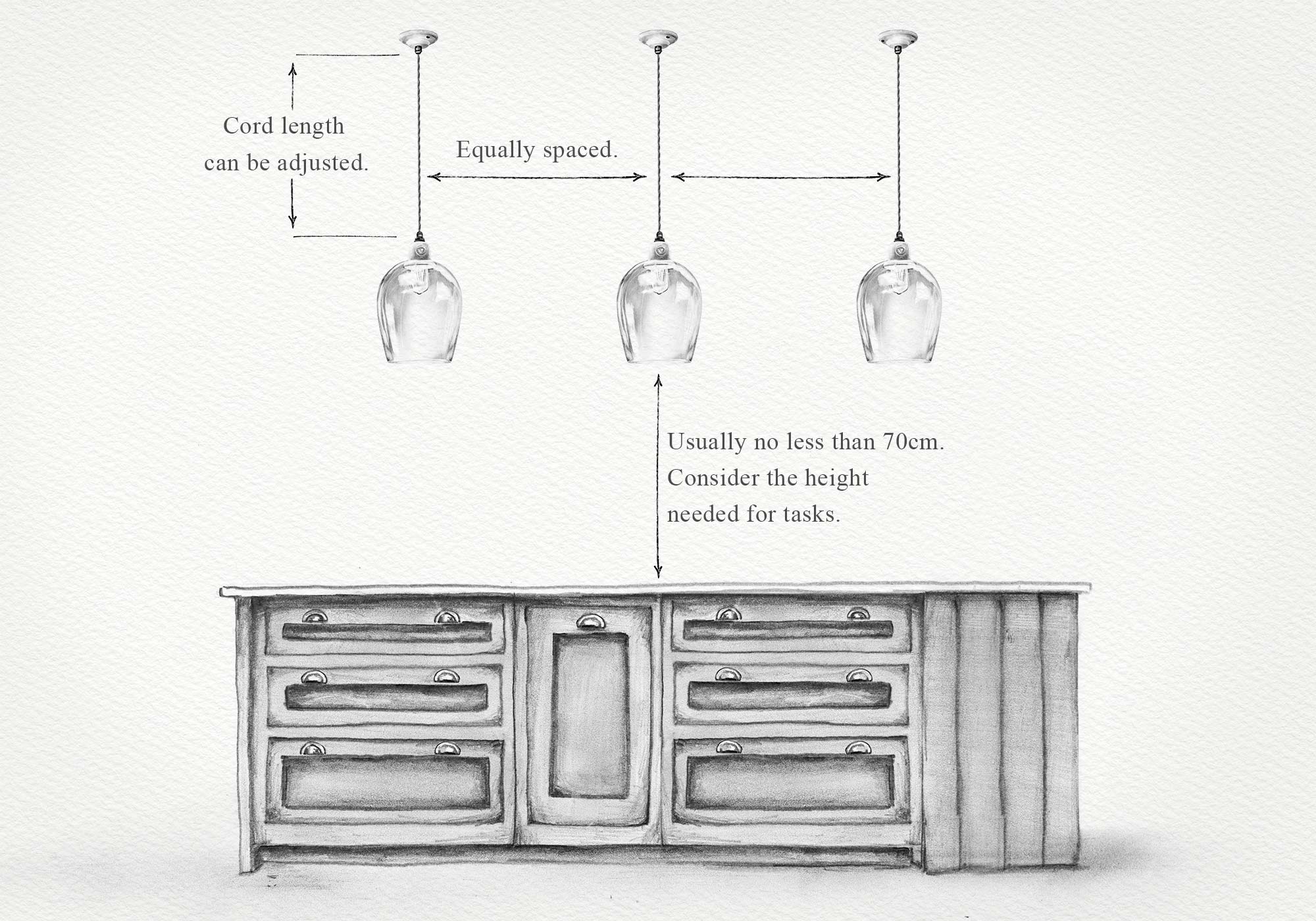
Height
Consider the height of your ceiling and the space required for the tasks you’ll be using your kitchen island for. It’s a popular trend to have your pendants low in the room, but balance this against practicalities. Generally, you should allow at least 70-90cm (2.5ft to 3ft) from the countertop to the lowest part of your pendant. Of course, anything higher than this is a personal aesthetic choice. All of our pendants are easily adjustable for height at installation. They come with 1 meter of cable as standard, but there are options for longer cord should you have exceptionally high ceilings.
Lighting a Dining Table

Interior Design and Image by: Steph Gowla
Dining table lighting is important as it needs to be multi-functional. To provide an even, sufficient light across the entire table, to create an atmosphere and ambience, and to help with kitchen ‘zoning’ – so that it creates a focal point even in daytime, evident that it is an eating area.
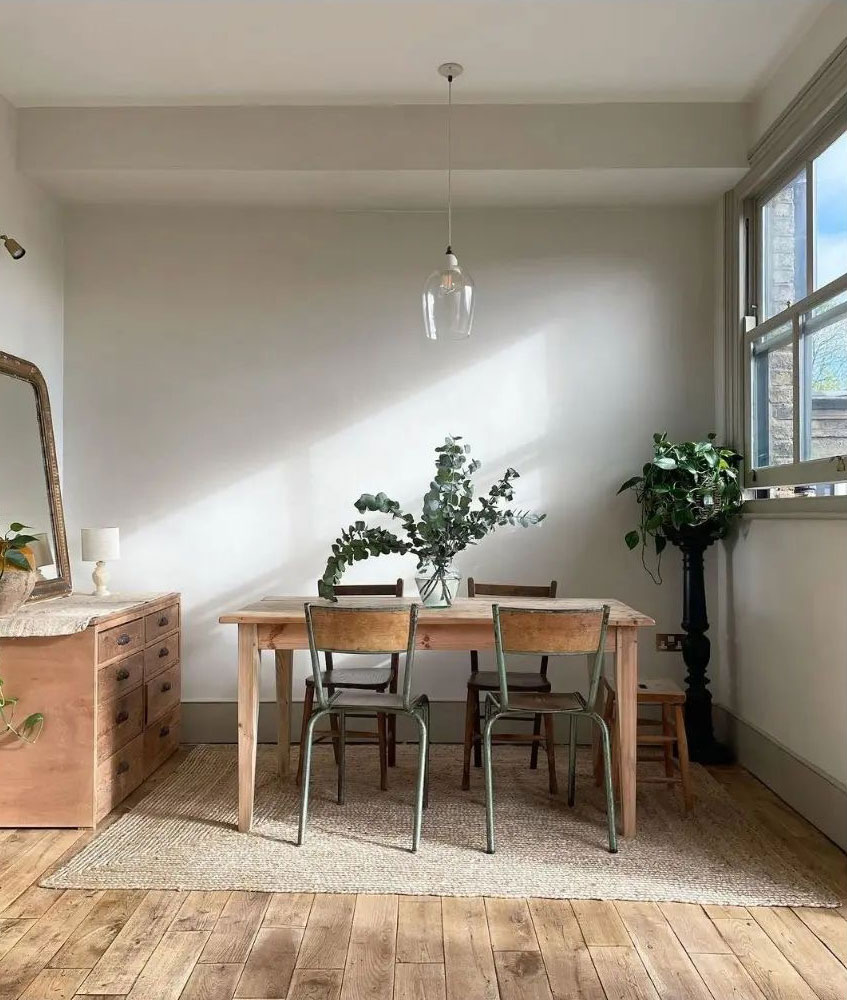
Interior Design and Image by: Sam at Vintage Curator Interiors
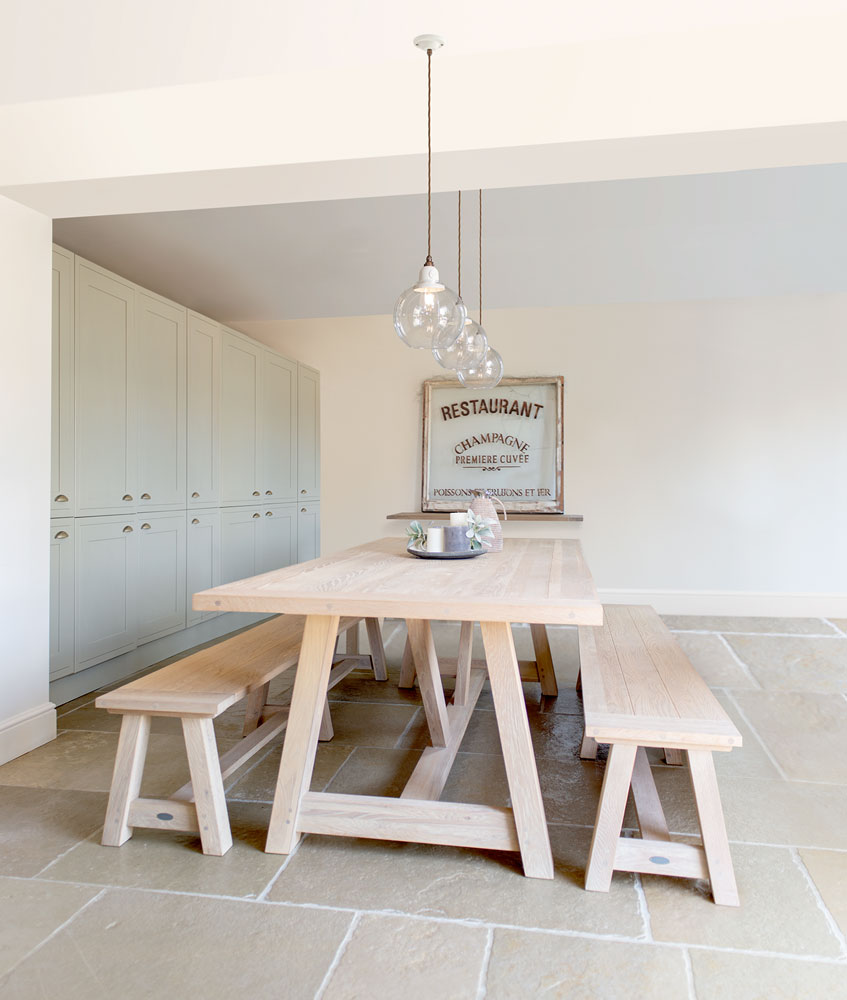
A central, single pendant can work beautifully, creating a solo point of light which washes over the whole table. For larger dining spaces, multiple pendants could be used to create balance across the table.
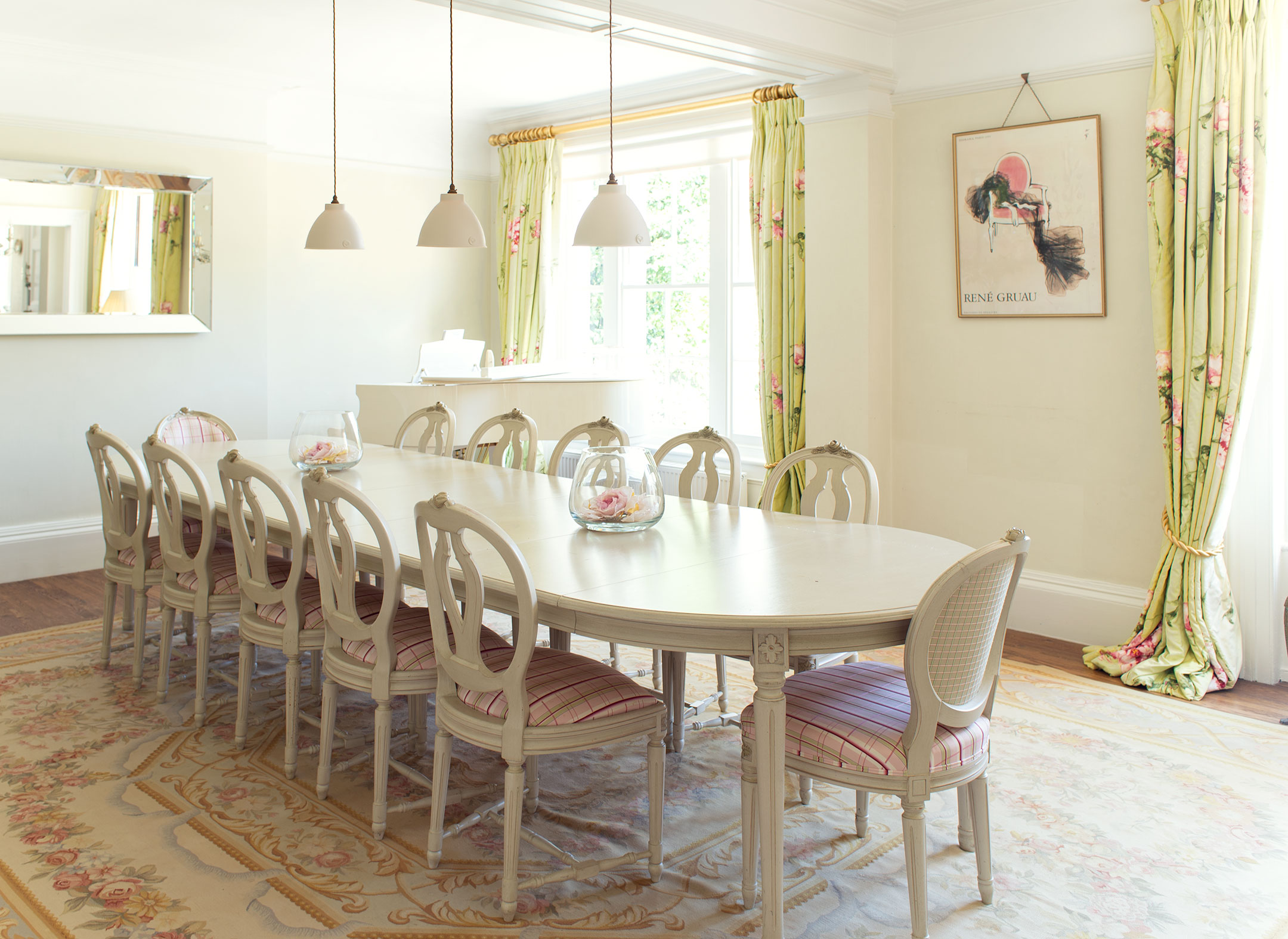
Dimmable Light A dimmer can be a wonderful solution for setting the mood and ambience from day to evening, particularly in social and dining areas. If your kitchen lighting is separated into different circuits, it may also be worth using more than one dimmer, to allow control over the different areas or ‘zones.’
Ensure the dimmer switch is of sufficient quality to avoid an annoying buzzing sound and that it is correct for the type of dimmable bulbs you are using. Note that LED bulbs use vastly less energy than filament bulbs and so LED compatible dimmers need to be used. All of the bulbs we supply are dimmable.

Consider task lighting when thinking about the practical uses of your kitchen, and fill in the gaps where light is lacking, i.e. food preparation, cooking and cleaning up.
The kitchen often features a wonderful array of materials and textures: marble, wood, granite, stone, tiles, exposed brickwork. By positioning lights close to these beautiful surfaces, you can bring out the unique patina of the texture, creating an interesting feature and focal point.
Task Lighting can be a wonderful opportunity to ‘mix up’ and get creative with your lighting scheme, using a mixture of smaller pendants and wall lights. A single pendant above the sink or a row of pendants along the worktop area can work beautifully, whereas the use of wall lights in corners, nooks and recessed areas can transform the look of those spaces.
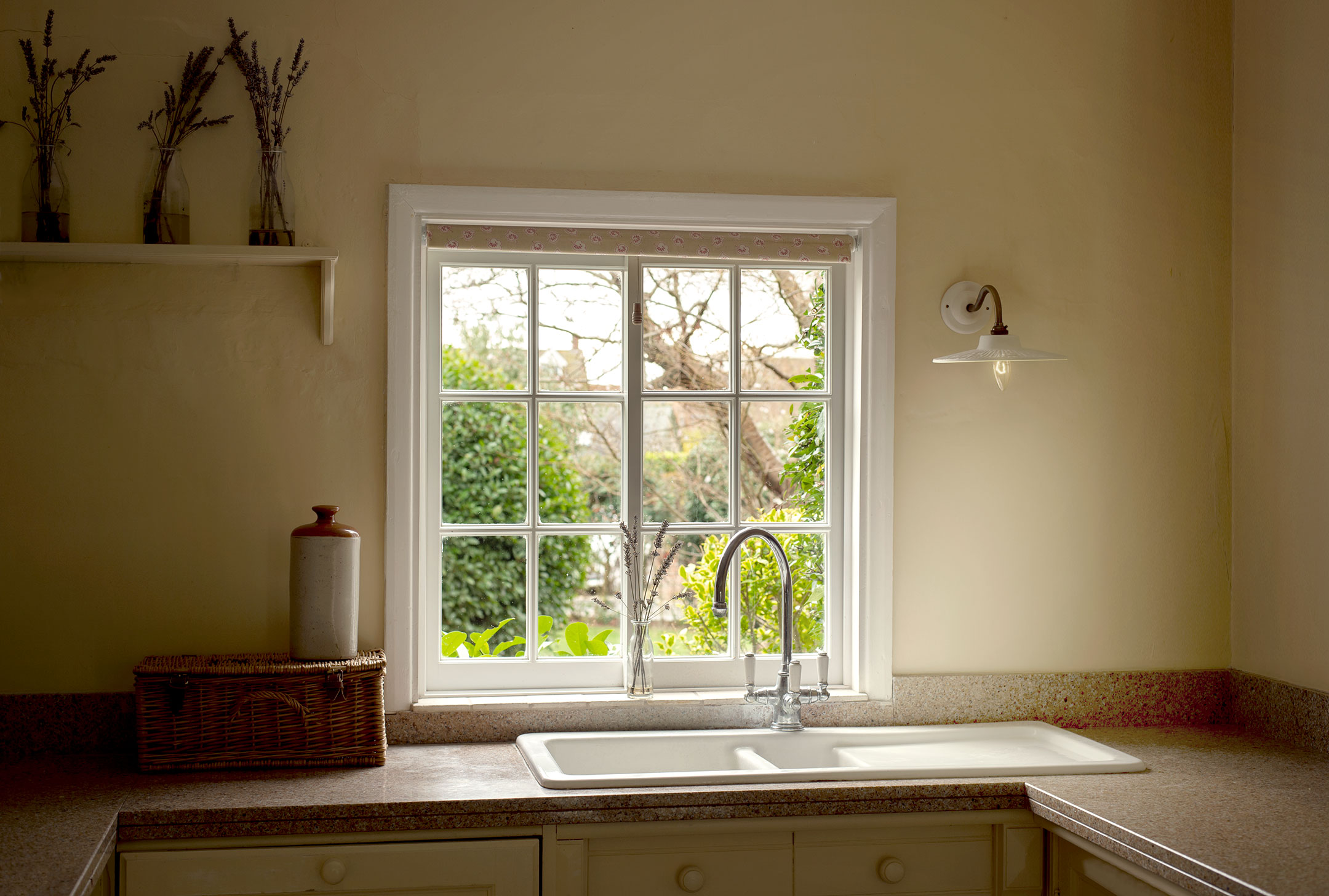
Wall lights can serve as an excellent task light, to shine down on preparation areas and sideboards, whilst also being a beautiful feature in themselves.
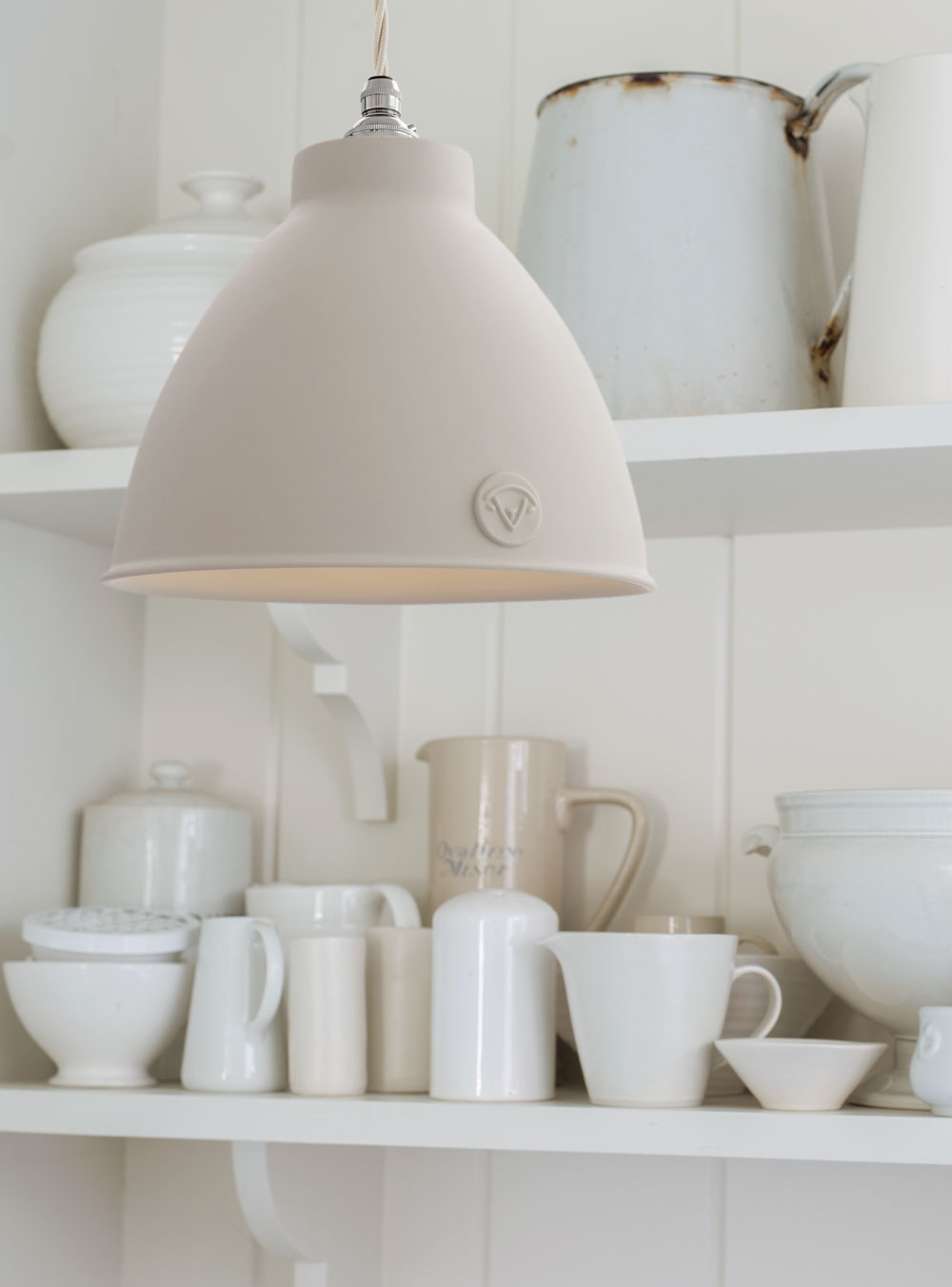
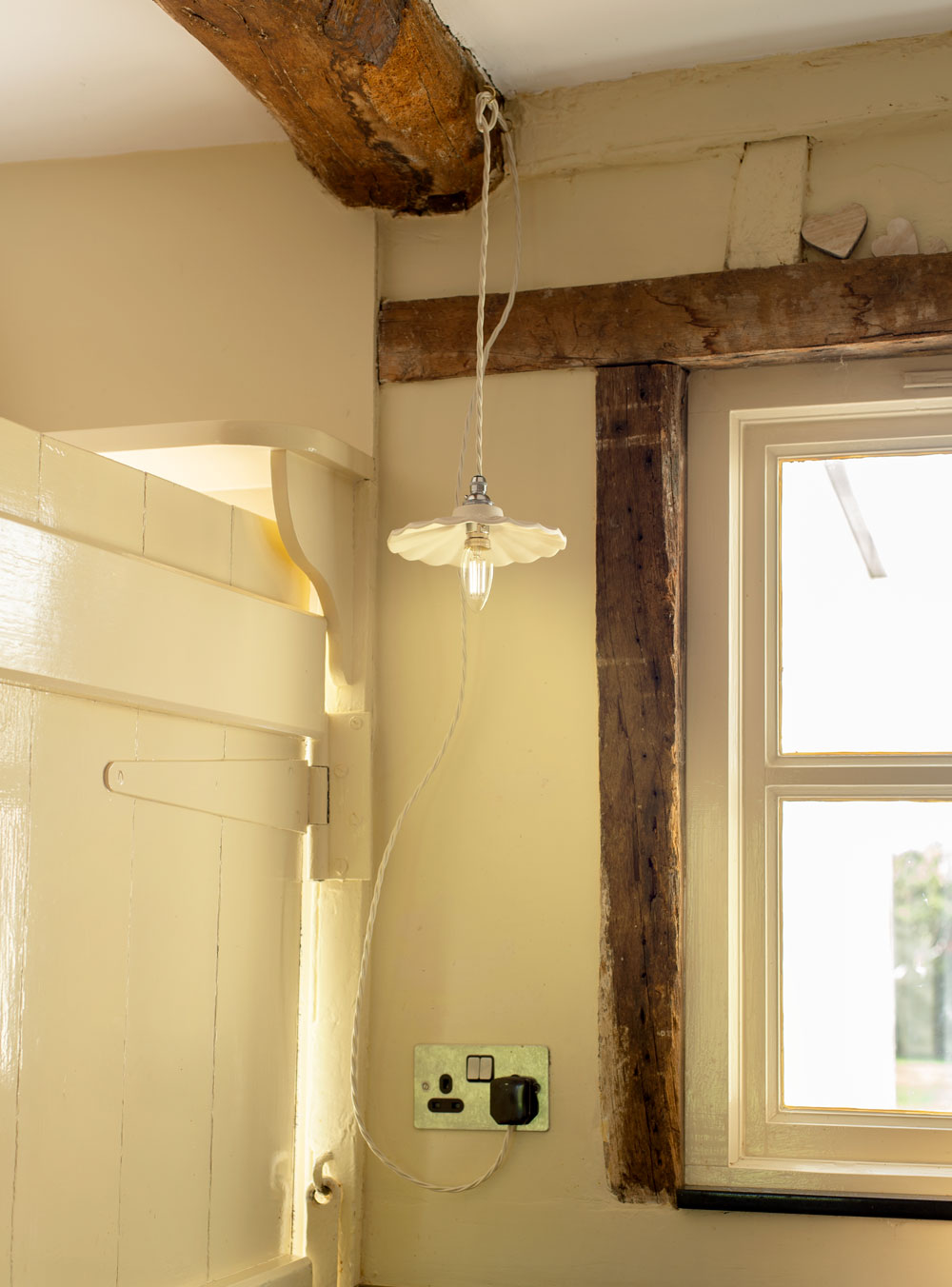
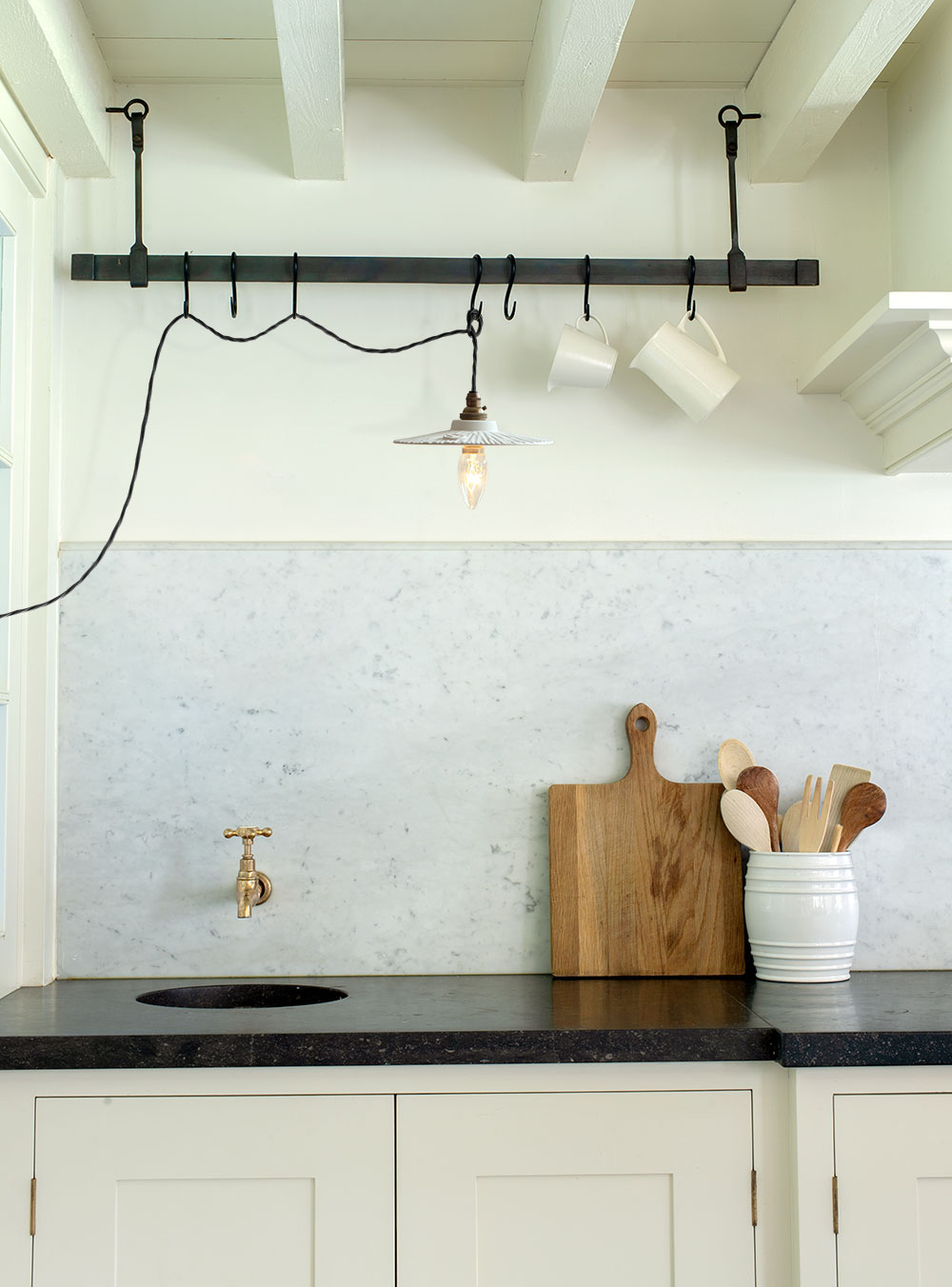
For features such as shelves and beams, ceiling hooks and nails can be a useful and stylish solution for pendants to make them sit just right for the space.


When the light itself is the object of beauty and interest, adding style and character to the room, and enhancing the visual aesthetic of the space. Whether your kitchen is traditional or contemporary, rustic or sleek, neutral or dark, there are Lam Lighting styles to suit. All of our lights have been meticulously and thoughtfully designed, to sensitively fit into any room whilst quietly making a stylish statement. Whether it’s the beautifully domed Gainsborough, the elegantly scalloped Giselle, the delicately fluted Millais or the streamlined industrial Heathcliff, you can rest assured that any one of our designs will effortlessly create a focal point in your kitchen.
Feature Kitchen Wall Lights
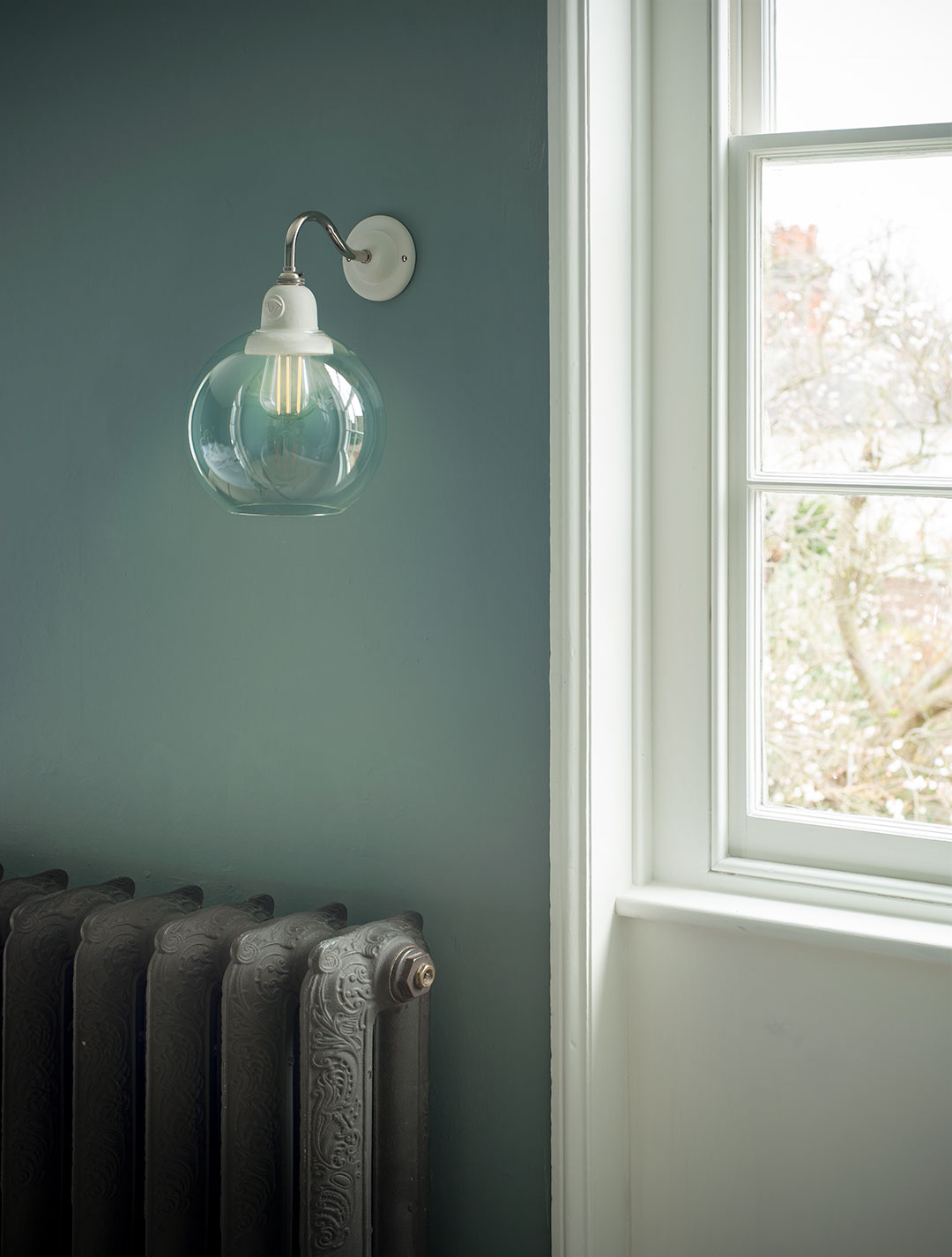
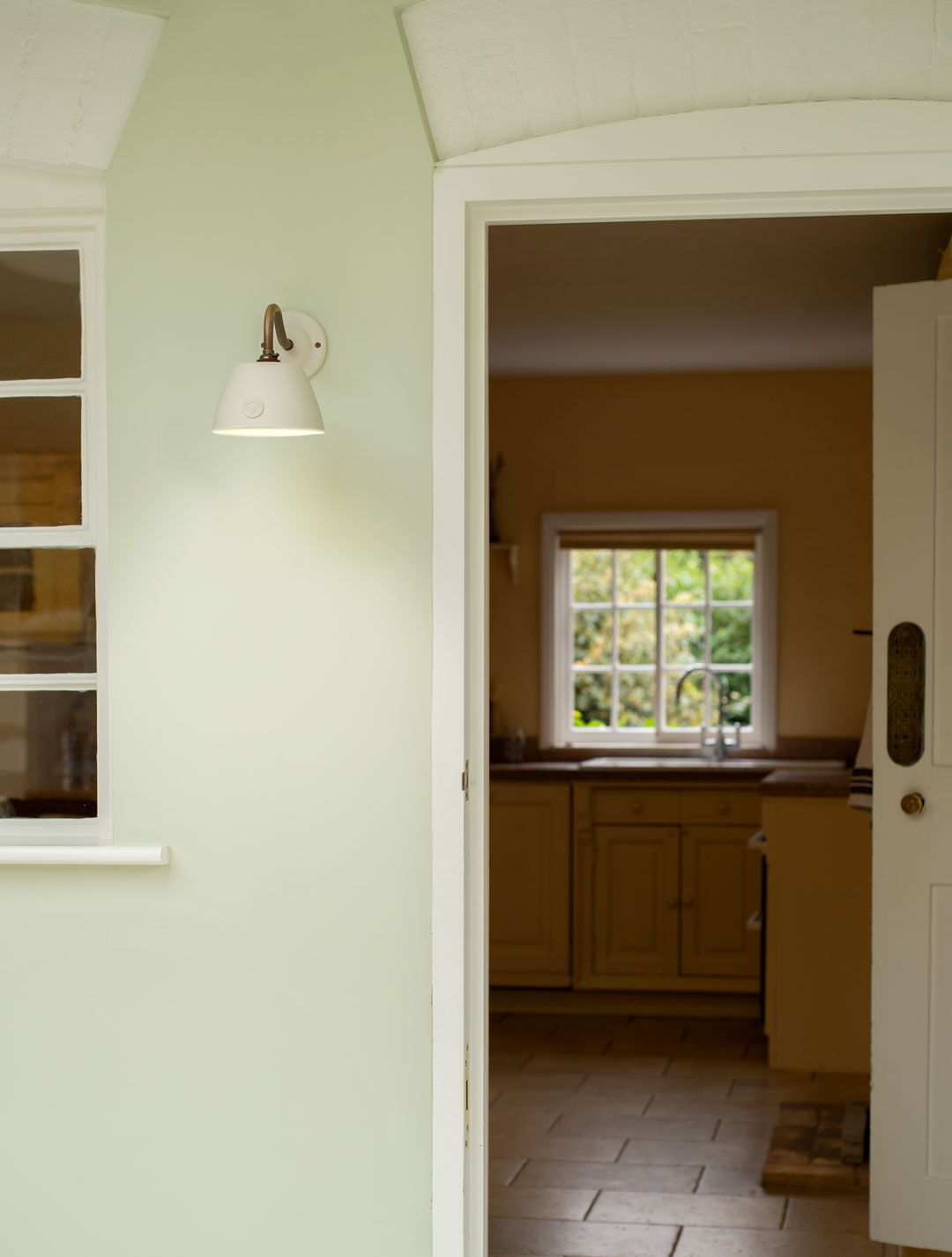
To further extend the style and character of your kitchen, consider the use of wall lights as an alternative to downlights and spotlights. Not only will wall lights add charm and character, but the individual pools of light will also help to add depth and enhance the textures in the kitchen. Wall lights are a great option for low ceilings, making use of the vertical space rather than the overhead space, to create a warm atmosphere.
In recent years, shelving has become ever more popular in kitchens – a wonderful storage and display solution, taking up less space than wall units. Wall lights are a stylish way to illuminate your shelves, simply position the light directly above the shelf to allow the spill to wash over.
Mix It Up
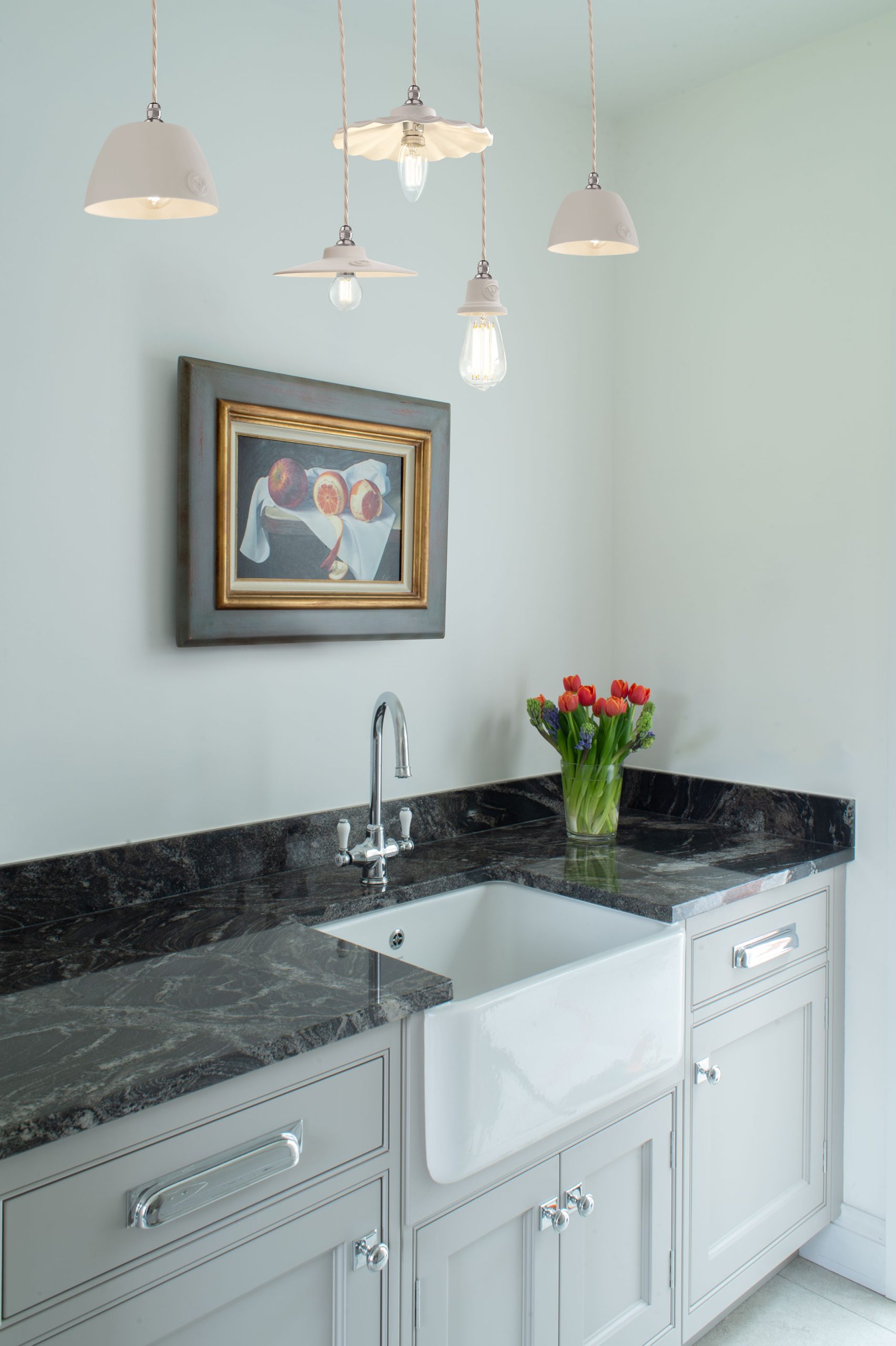
Combine different shapes and sizes, pendants and wall lights. All of our lights use our signature porcelain and can be specified with your choice of fittings and cord. So mixing and matching can be done in confidence, with all the lights being in harmony. You can pick any number of lights from anywhere in our range and know that they will blend seamlessly, all with the same simple and pure materials and tones.
Further to this, because all of our lights are modular, then every shade fits every pendant. So, if in Summer, you want your kitchen to have a different look to Winter, swapping out the shades is as simple as removing a shade ring. To order shades separately, please enquire. It’s never been easier to refresh your lighting scheme for every season.
Don’t be afraid to experiment, the consistency of tones and materials in all of our lights means that you can be creative in mixing and matching shades to create some really wonderful effects.
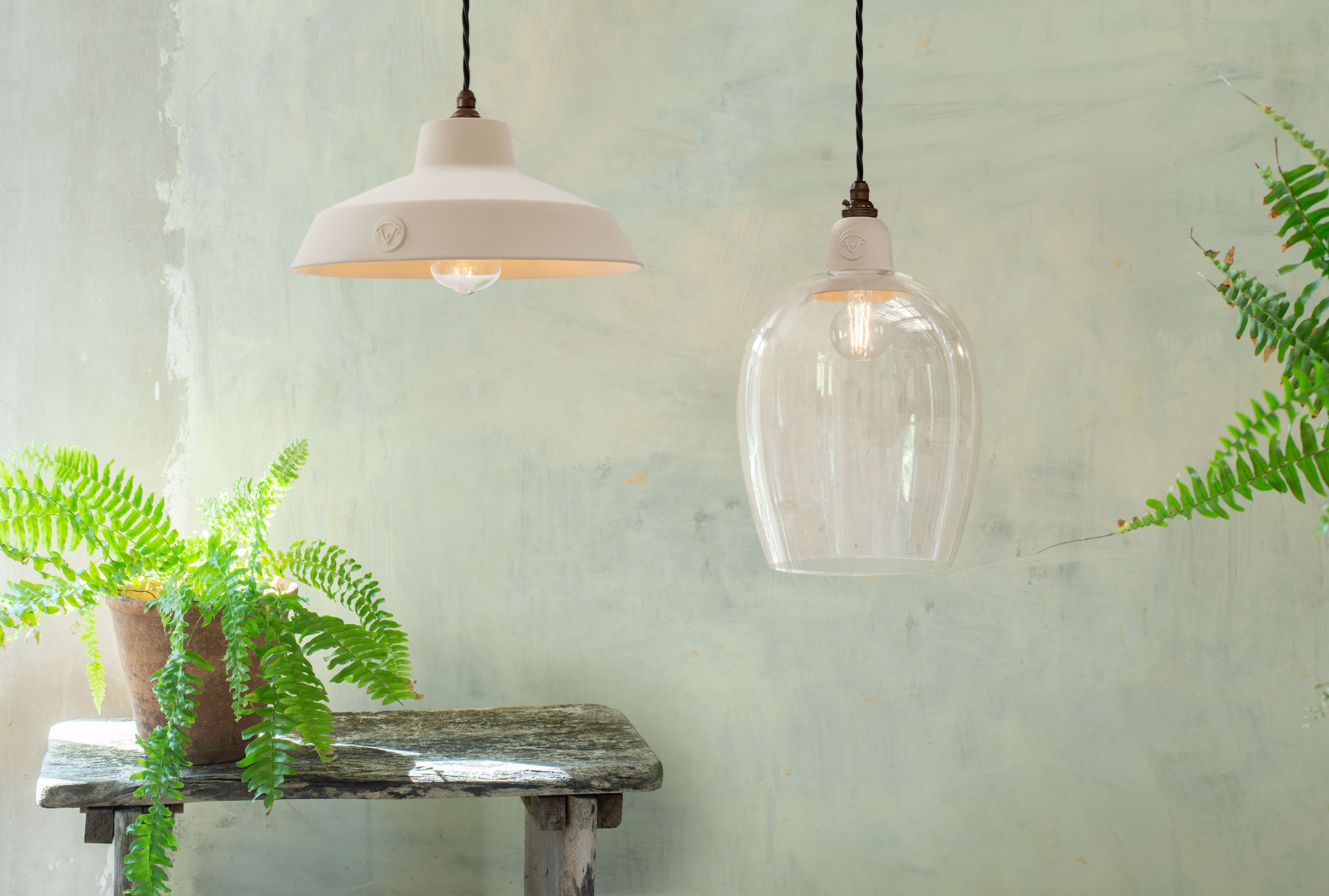
Blend Modern & Traditional Styles
Kitchen design is unique, in that the aesthetic of the past is often called upon, but the functionality of the kitchen requires contemporary solutions, to incorporate modern taps, refrigerators and hobs. So even traditional kitchens have a modern aspect to them.
We have created traditional shapes and silhouettes with vintage cable and fixtures, realised in timeless glass and porcelain. Simple designs along with purity of materials. Contemporary yet timeless lights, that sit beautifully in both traditional and modern settings.
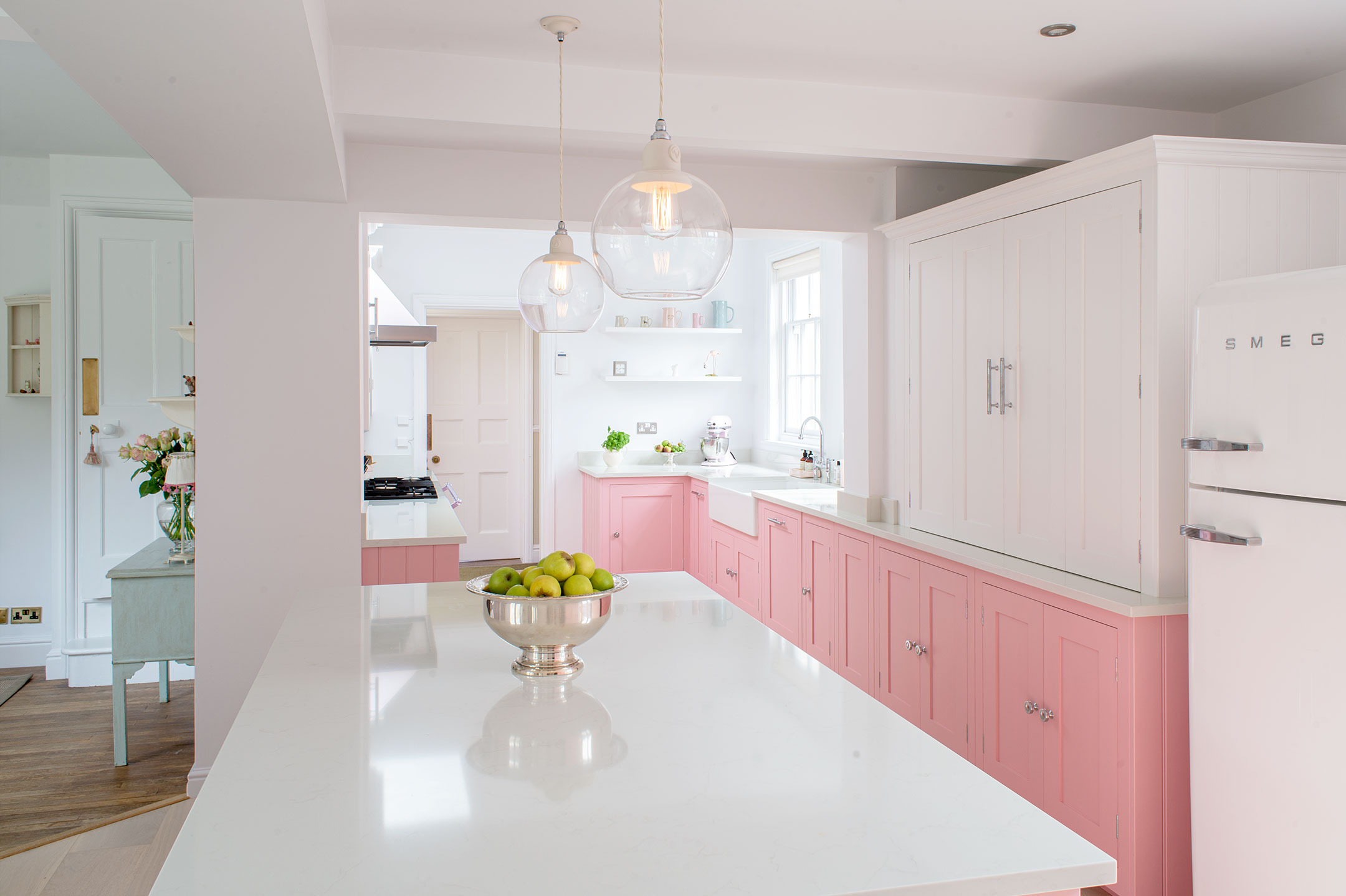
Fittings & Architectural Details
Time and again we hear that the devil is in the detail. You can match details of your lights to existing details in your kitchen, for example, if your door furniture, drawer pulls and hinges are in brass or chrome, then you can match these accents with the fittings on our lights. You also have options on different colour vintage cords, easily selected on our website.
No detail should be overlooked, even your choice of cord colour can be a statement. In a kitchen with a pale colour scheme, black cord will stand out and become a feature, whereas cream cord will disappear, sitting back and not drawing attention from other details. The same is true for cream cord in a dark kitchen, with the contrasting tones. In a period or vintage-inspired kitchen, where you desire your new lights to sit in harmony with the existing furniture, the antique gold cord is a sensitive touch.
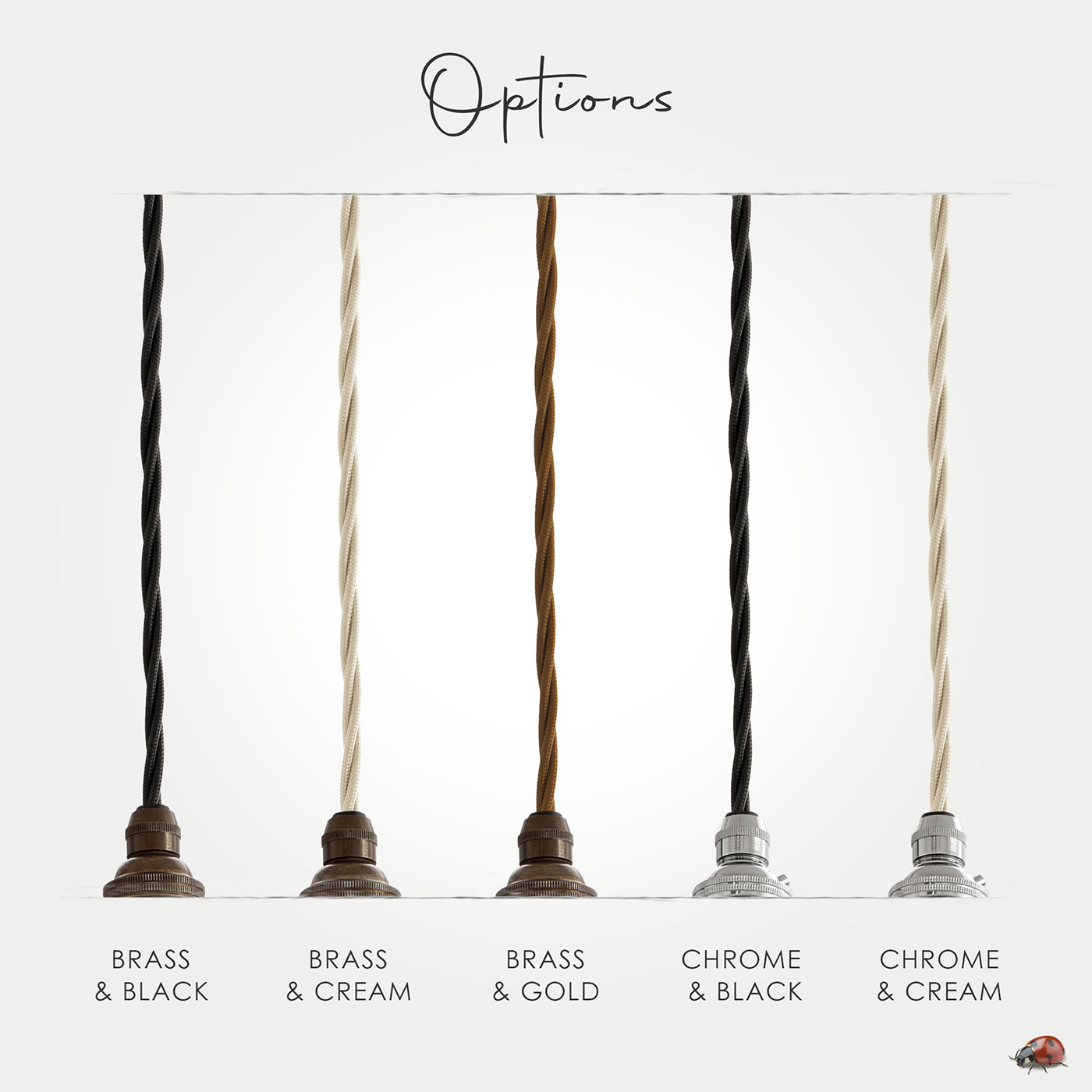
Draw inspiration from any architectural features and quirks in your kitchen. For example, circular archways could be echoed in your choice of shade, as in our domed Bronte light. If your kitchen has an industrial feel, you can reinforce this theme with our Heathcliff shade, which calls upon the industrial era shapes, yet in fine porcelain, it becomes a luxury light fit for your home.
Fittings & Architectural Details
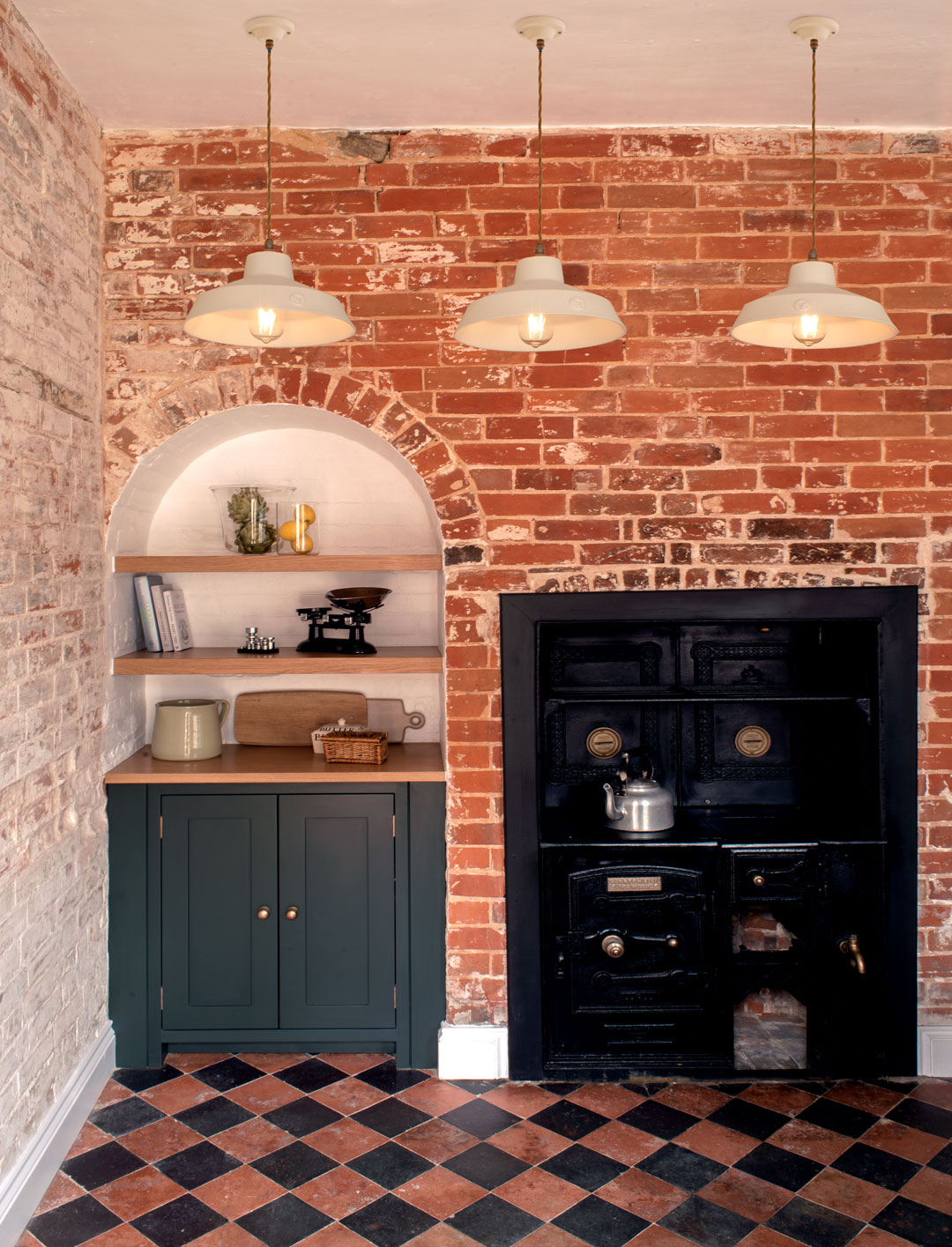


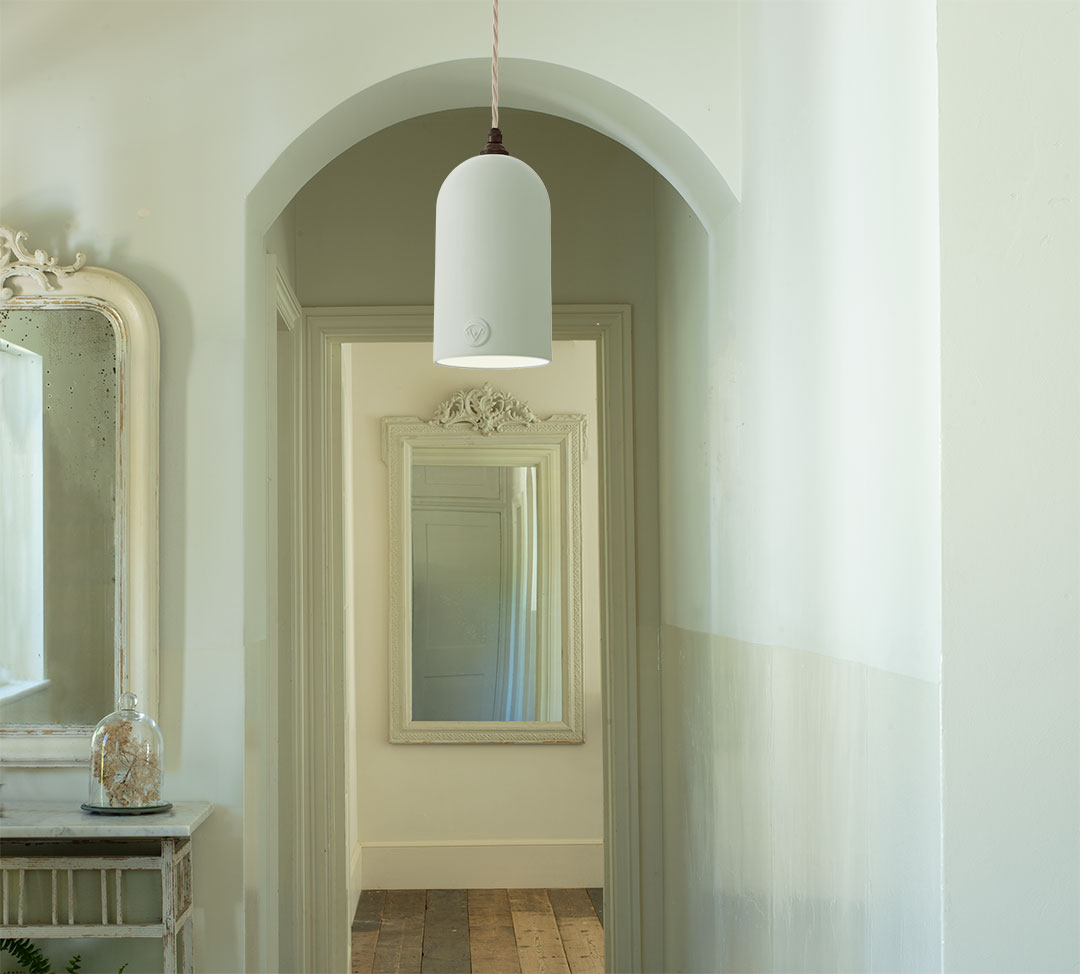
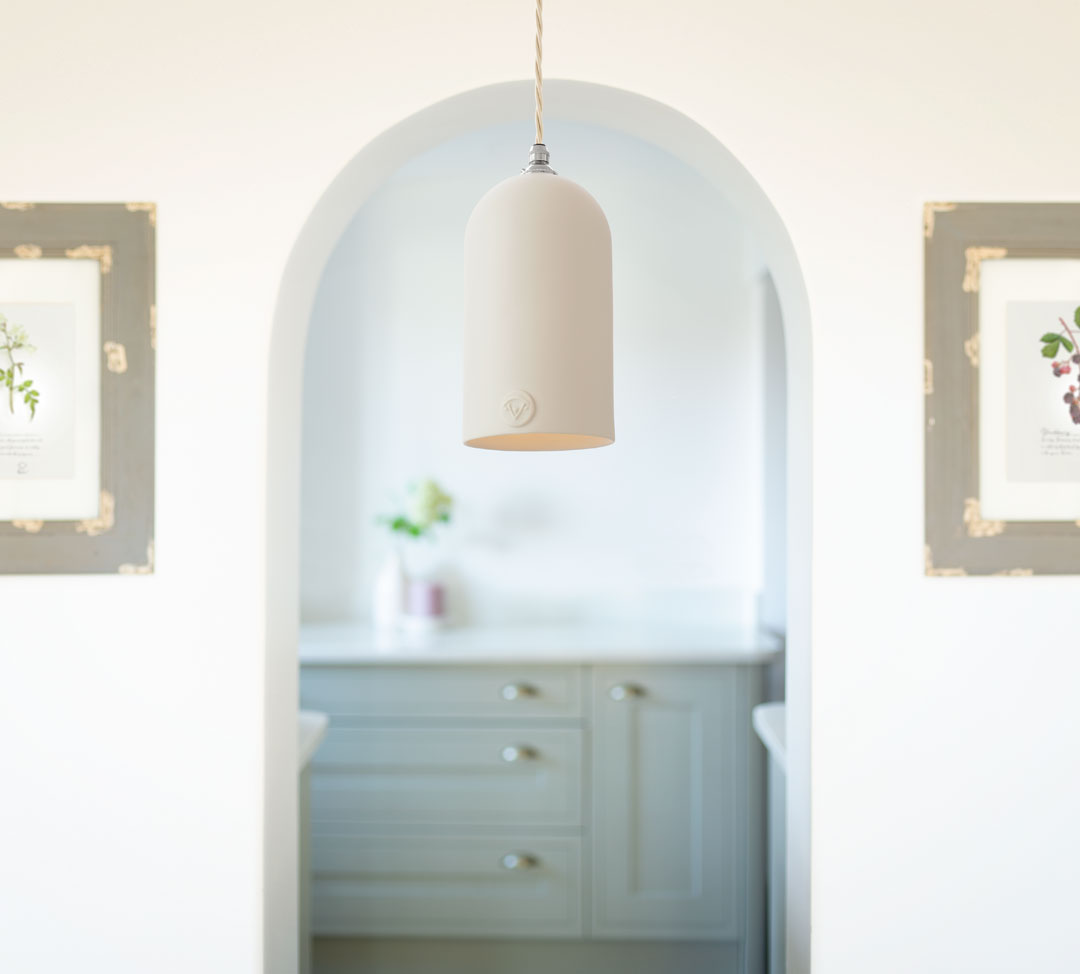
Ceiling Clamps
Ceiling clamps are a brilliant innovation. They enable you to position lights in places previously unavailable. For example, if your ceiling rose is not where you would actually prefer your pendant to be, you can simply install the ceiling clamp in your preferred space. This way, the cable can be draped between the ceiling rose and the ceiling clamp so that your pendant ends up exactly where you want it. Use multiple ceiling clamps with multi-pendants to create dramatic effects. Ceiling clamps are not alone a practical solution, but also a highly stylish design choice in their own right. The use of ceiling clamps is a fantastic way of maximising the visual effect of vintage cord and making the cord itself part of your lighting design. Our cord clamps are available in both Old Brass and Chrome finishes to match your existing scheme.
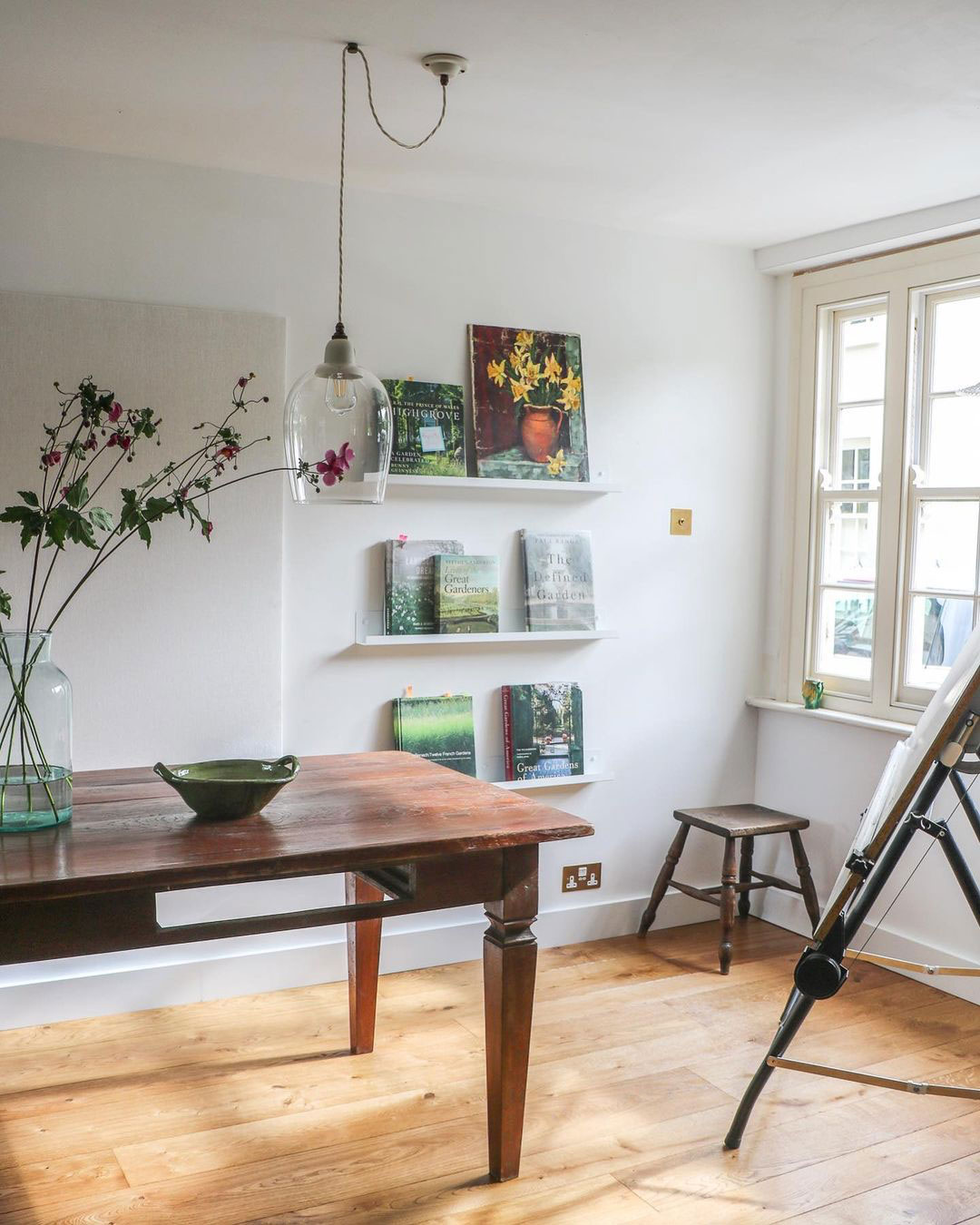
Interior Design and Image by: Lamb & Newt
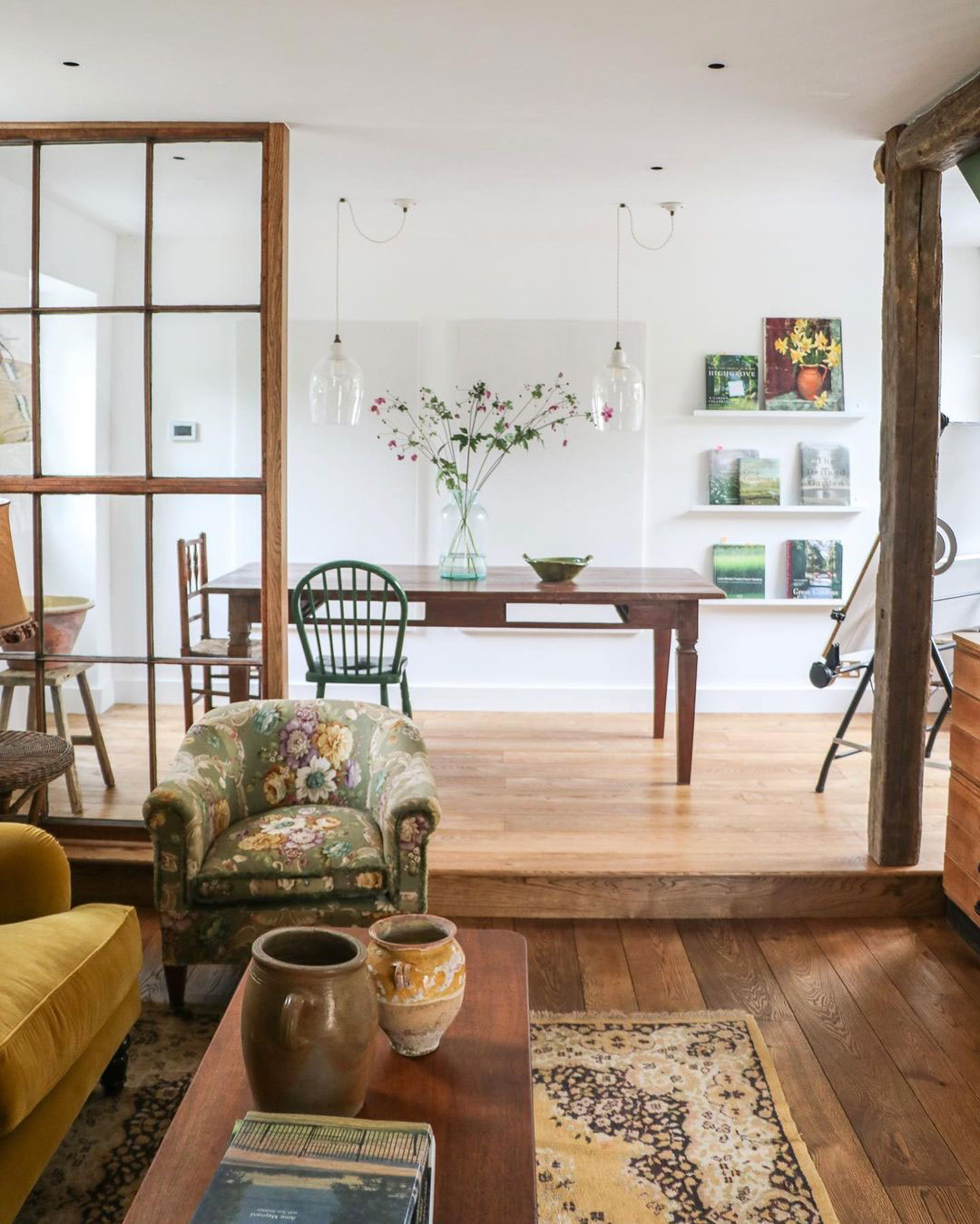
Interior Design and Image by: Lamb & Newt
Ceiling Heights
Different ceiling heights offer different lighting opportunities. Higher ceilings allow for longer pendants that cover the room vertically. A single pendant creates elegance through long, slender lines. Echo this look further with multiple lights to create sleek, parallel lines. For more drama, you can use multi-pendants that enable you to create vertical layers of light. As a rule, the lowest point of any pendant should allow for a minimum head height, this is usually no lower than 7ft (213cm).
Lower ceilings offer more intimate spaces, so shortening your cord length is a practical solution for head height. In some traditional homes where the ceilings are incredibly low, consider wall lights as an alternative to pendants. Wall lights are not only a beautiful way to light a room, but become beautiful features within themselves. Wall lights will light a more specific area than a pendant, so carefully consider where you place them. Pair them with dimmer switches to give you full control over the ambience. Zoning the dimmable areas will give you even more control. Consider a nook that might become your new favourite spot to read.
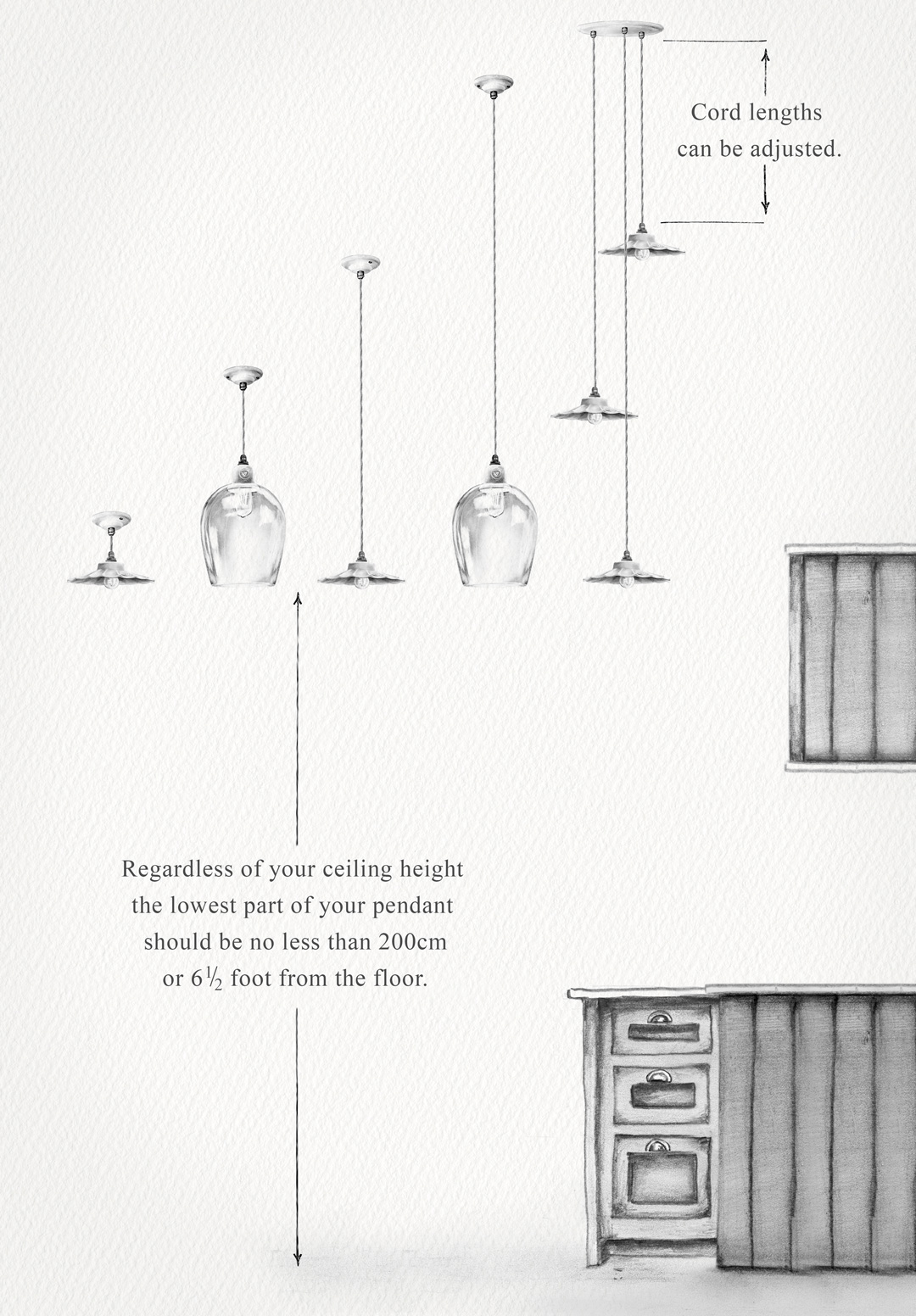
True style is more than skin deep
Your kitchen lighting should give a sense of luxury and satisfaction every time you see it in place. It should be something functional, that has been ethically produced from sustainable, eco-materials. Made with a beauty that goes deeper than the surface.
It’s Time to Embrace LED Bulbs
The rate of development in bulb technology over the past decade has been staggering, it’s nothing short of a revolution through LED’s and in the past 3 or 4 years, LED bulbs have become as elegant as their filament predecessors. It’s almost an unsung hero of the energy crisis – every bulb that is replaced with an LED equivalent saves about 90% of the energy use. That’s no small difference, and a very good reason to fully embrace them.

